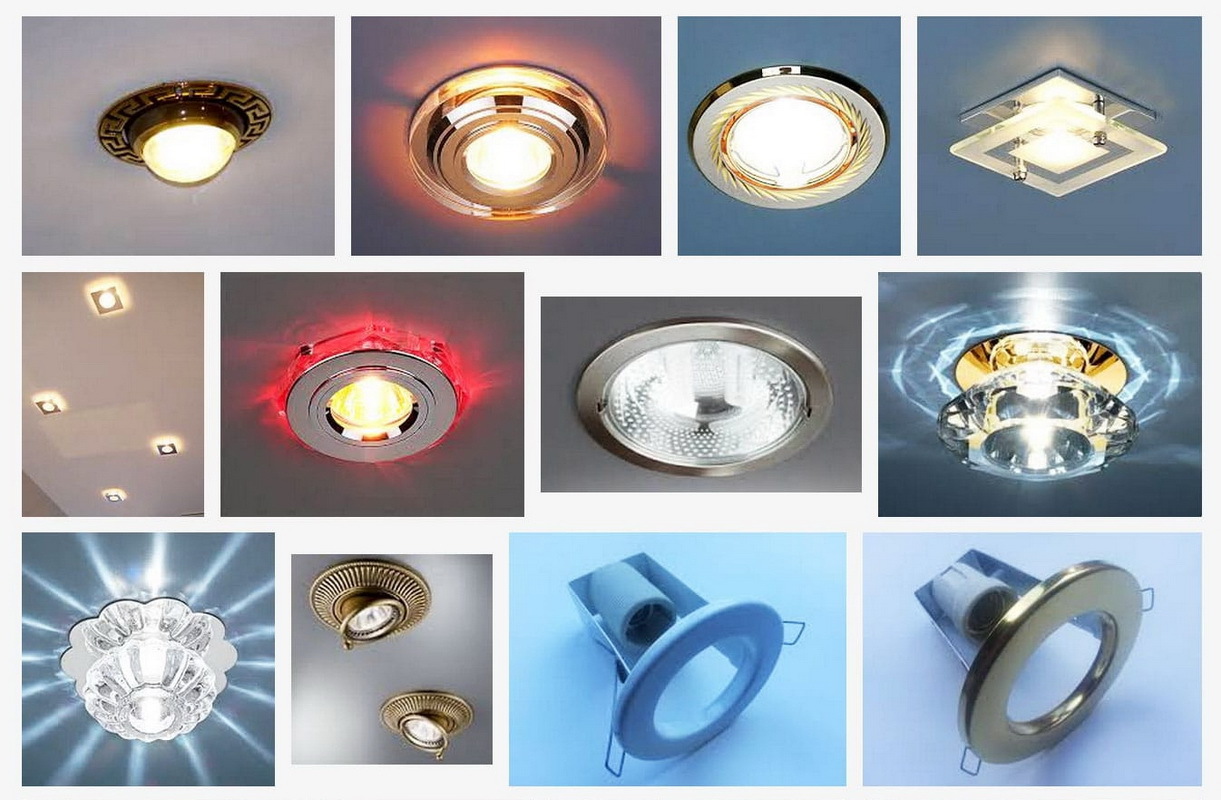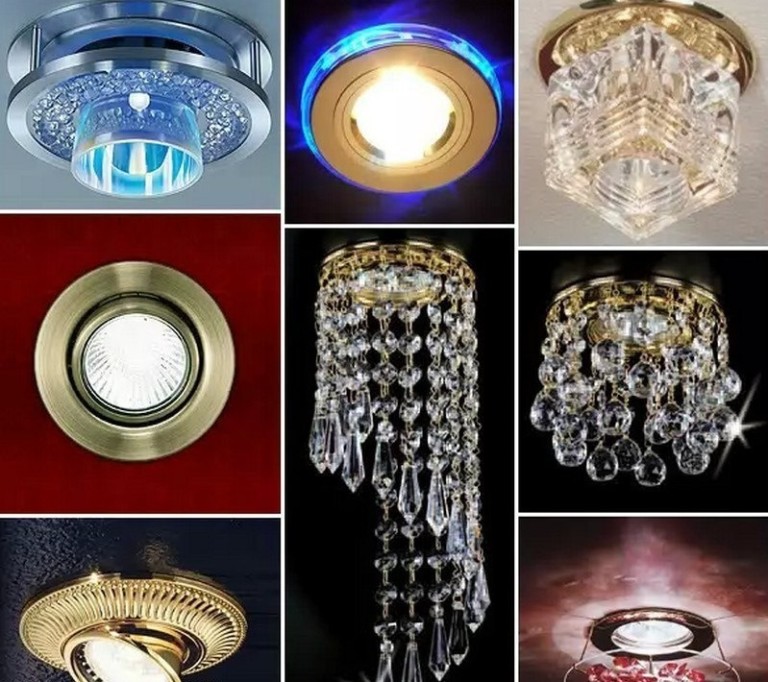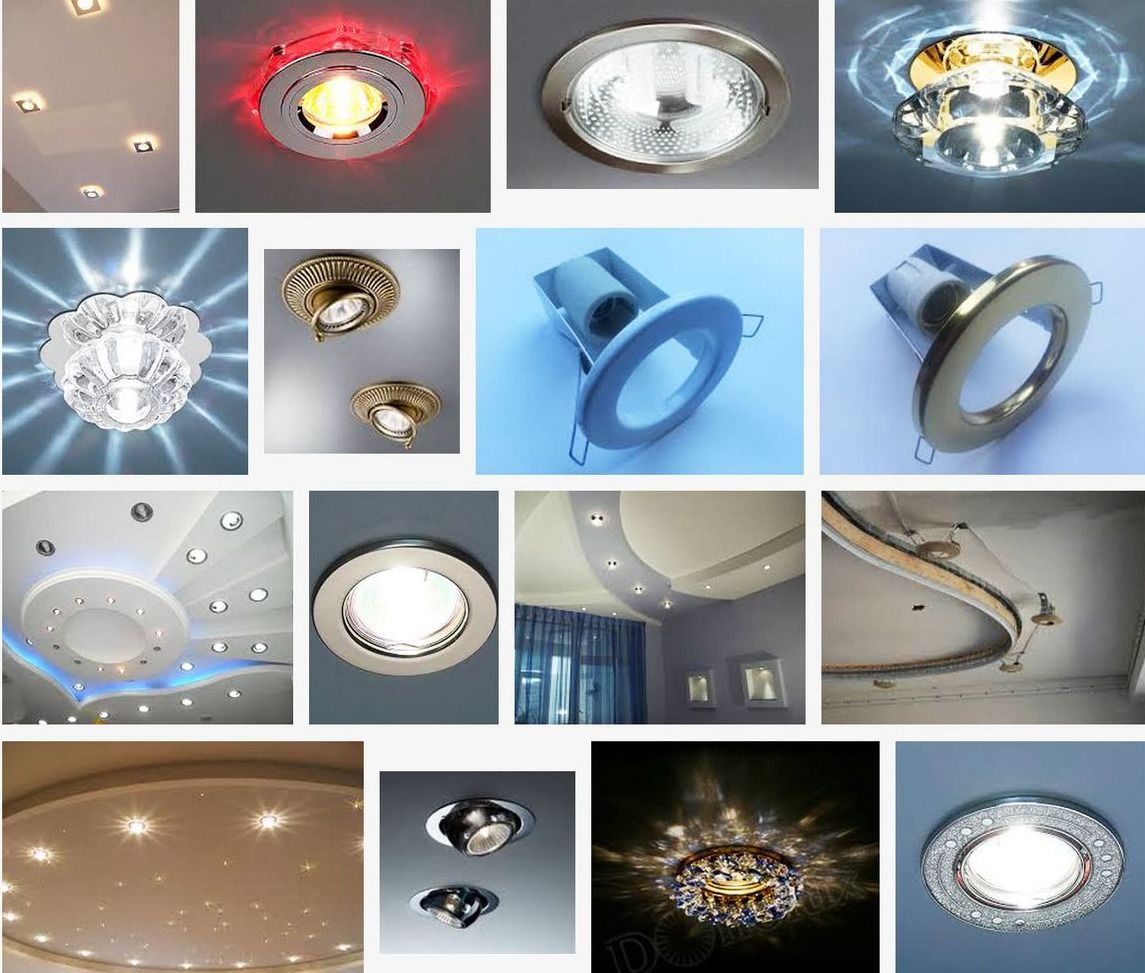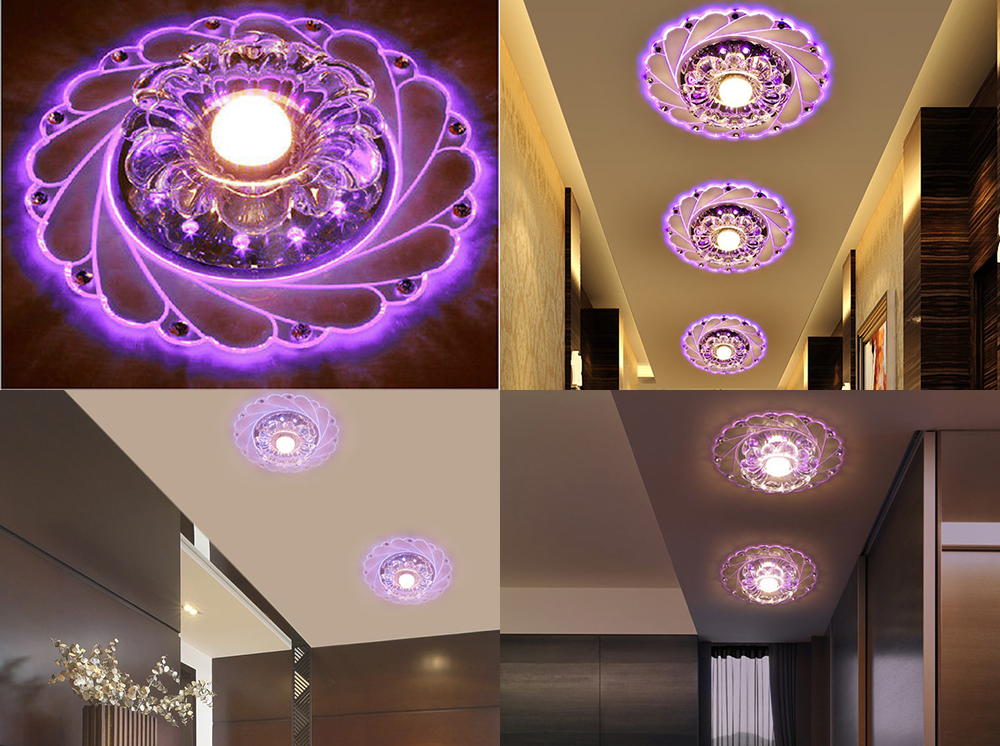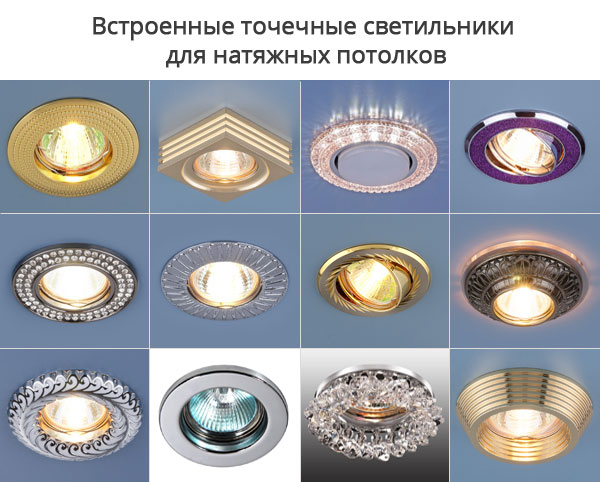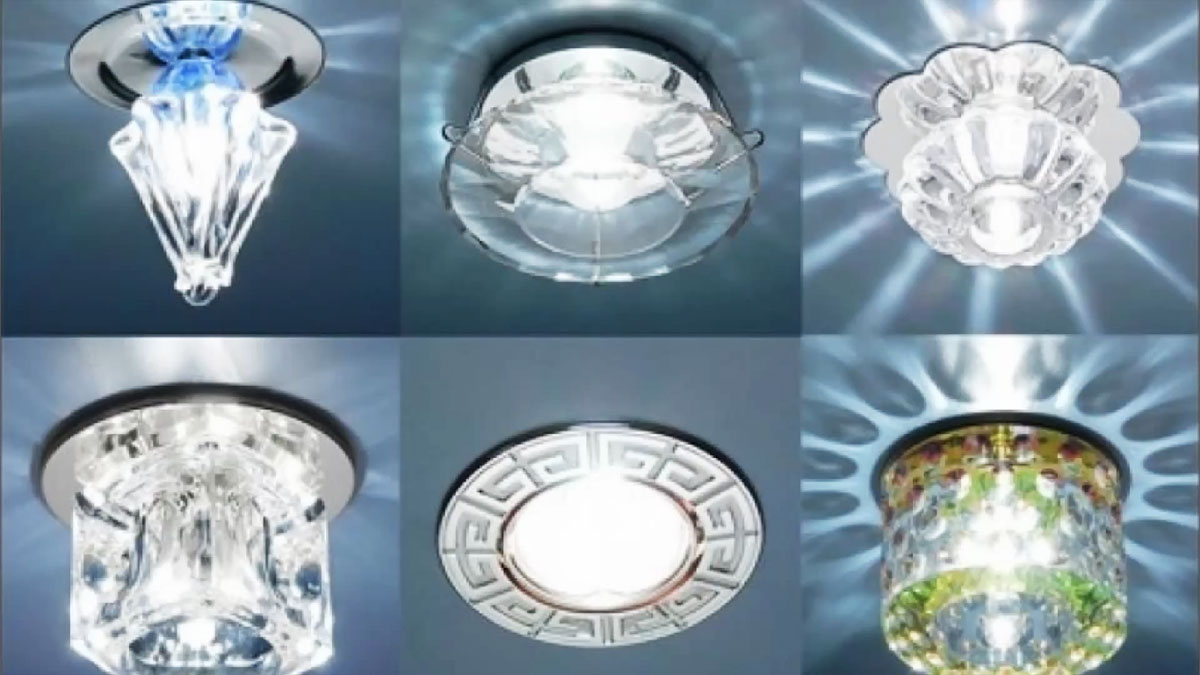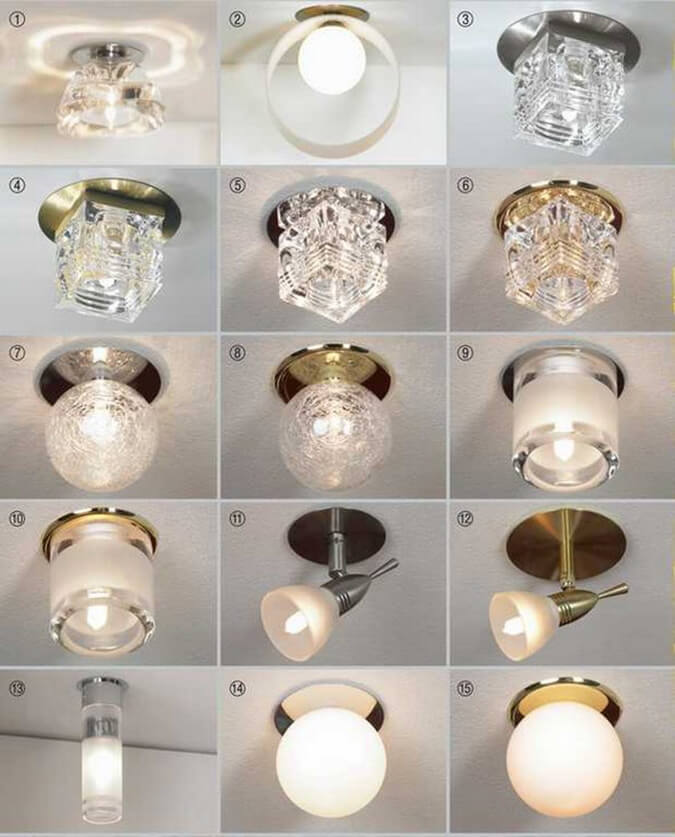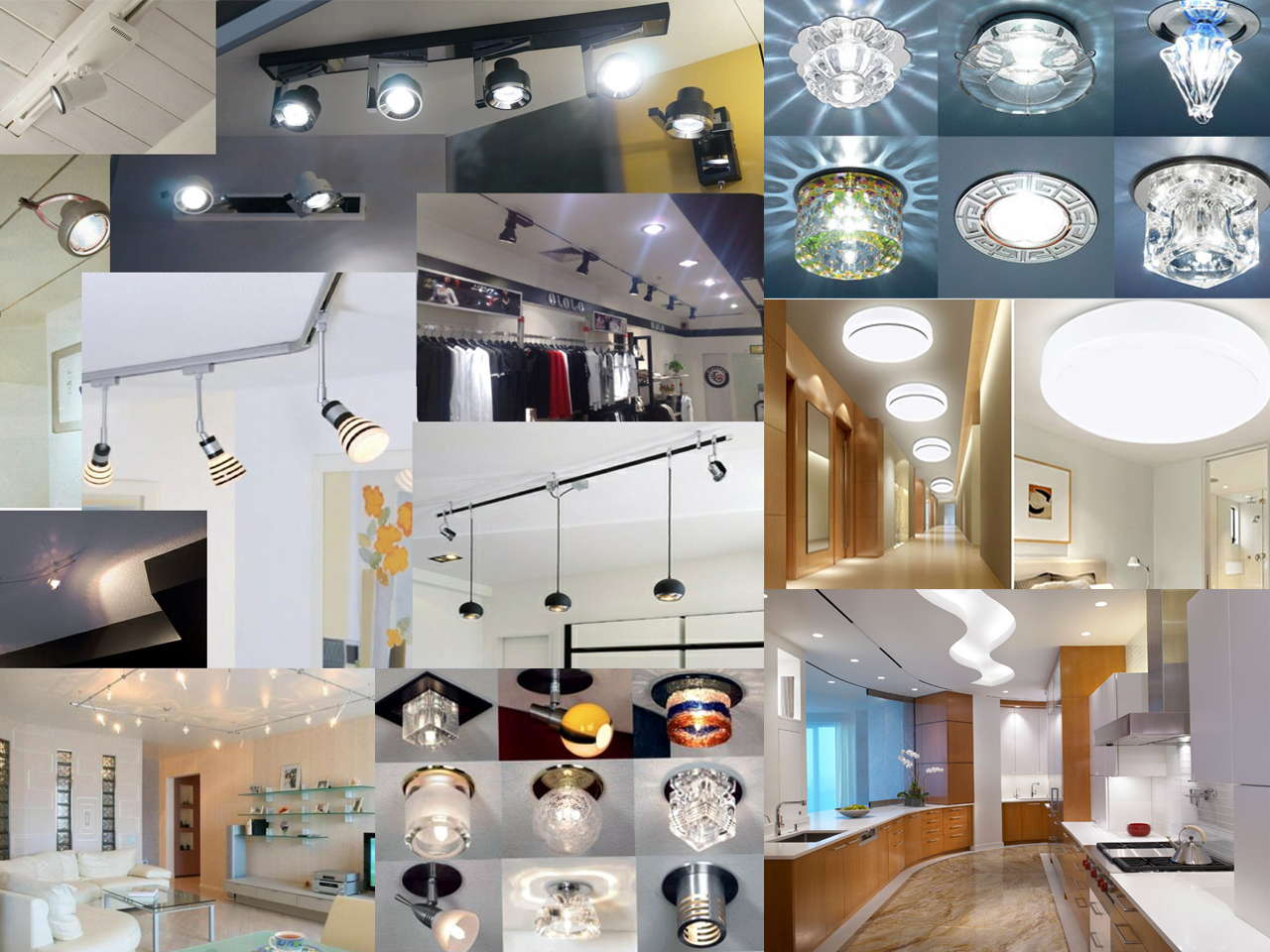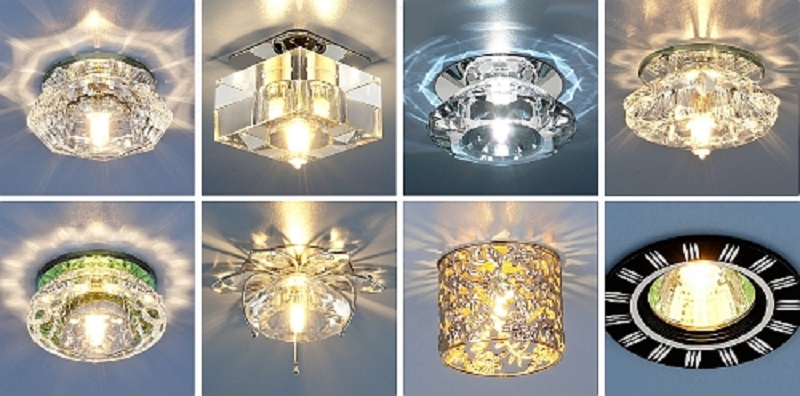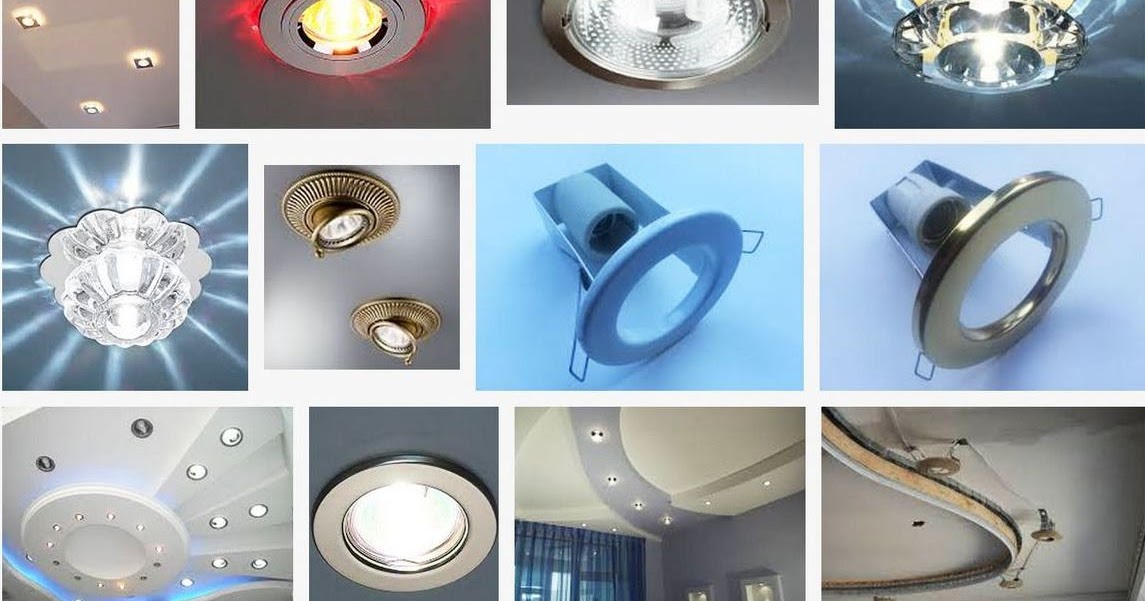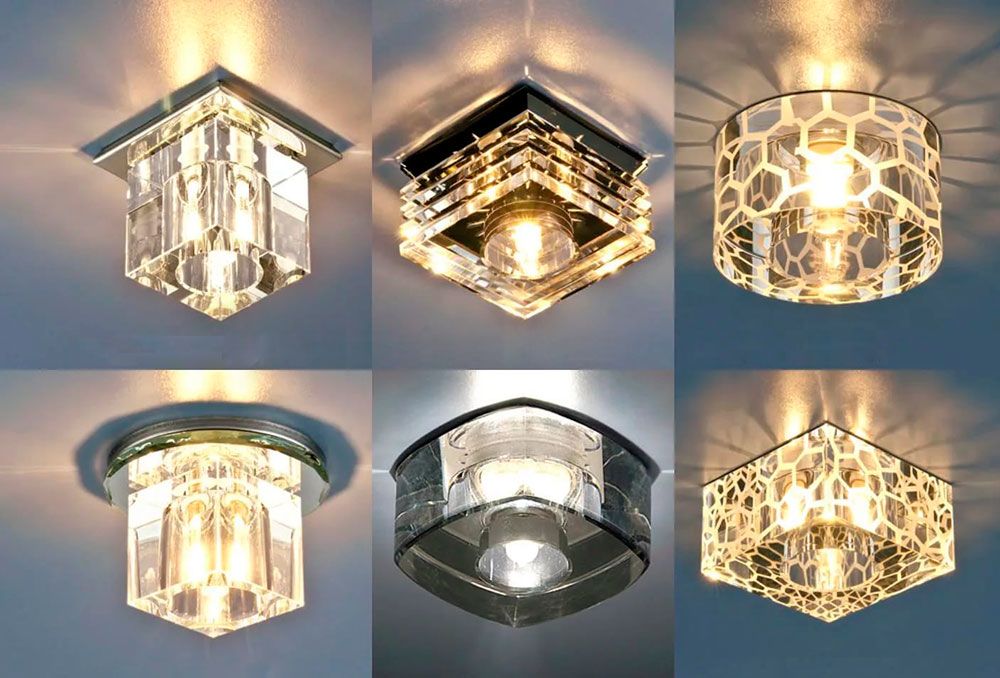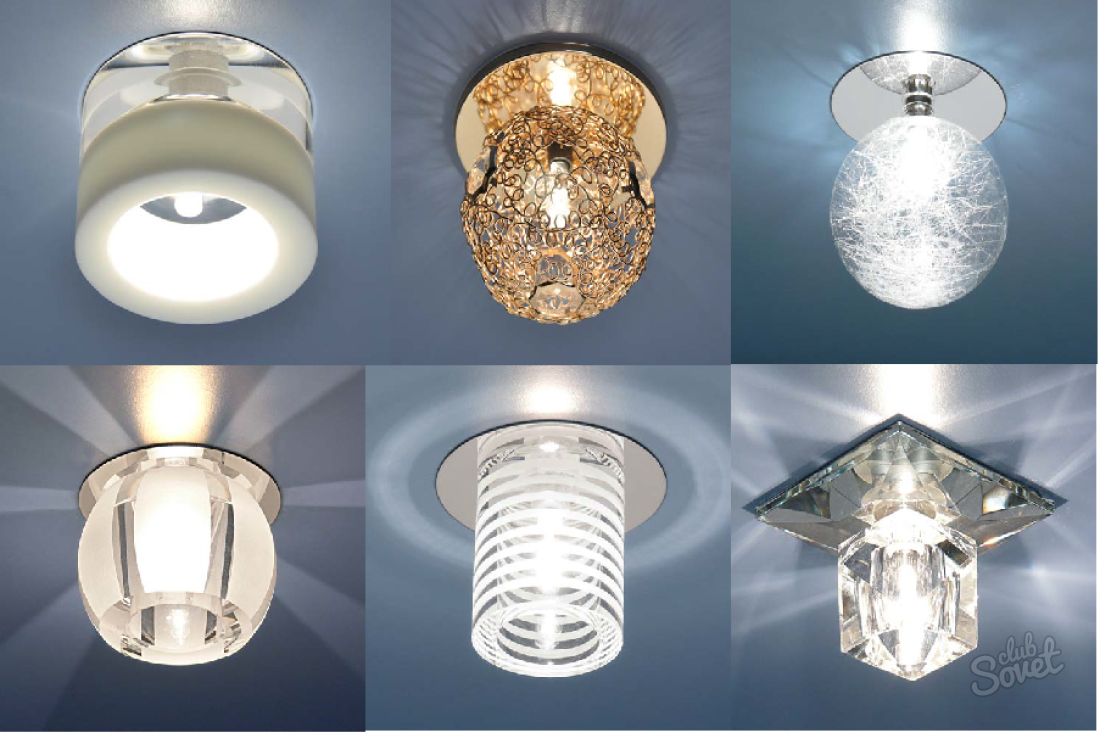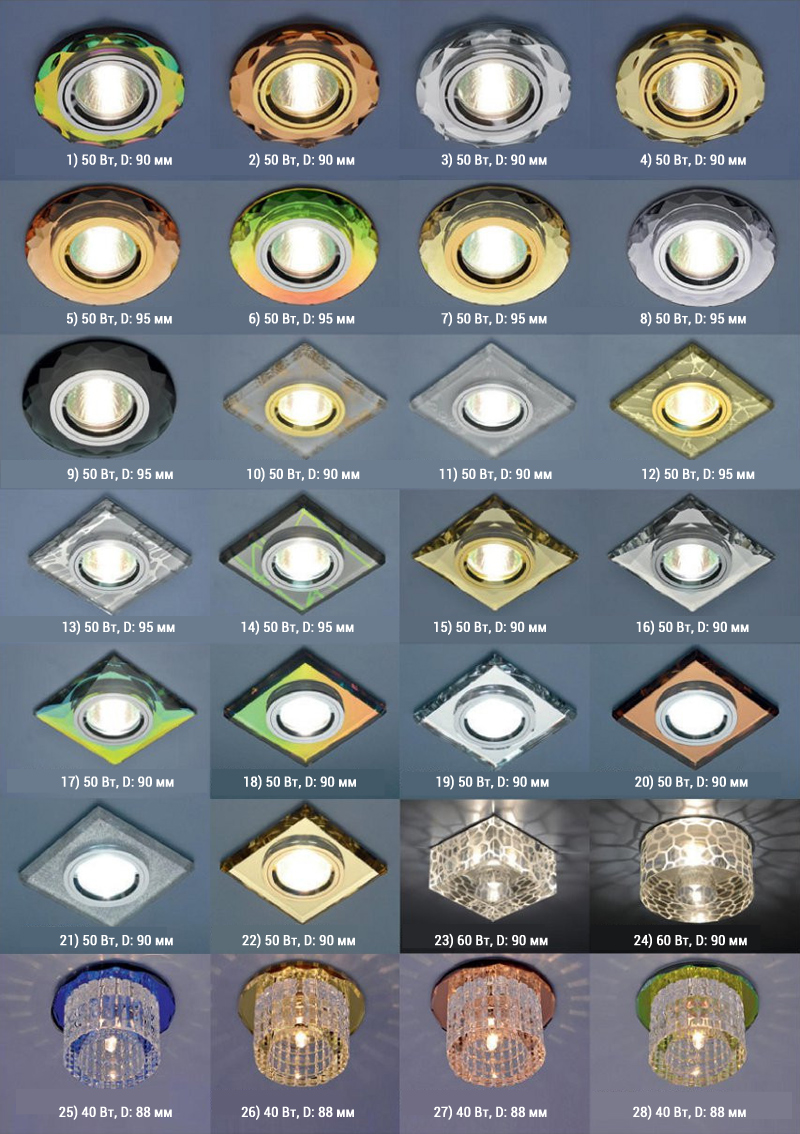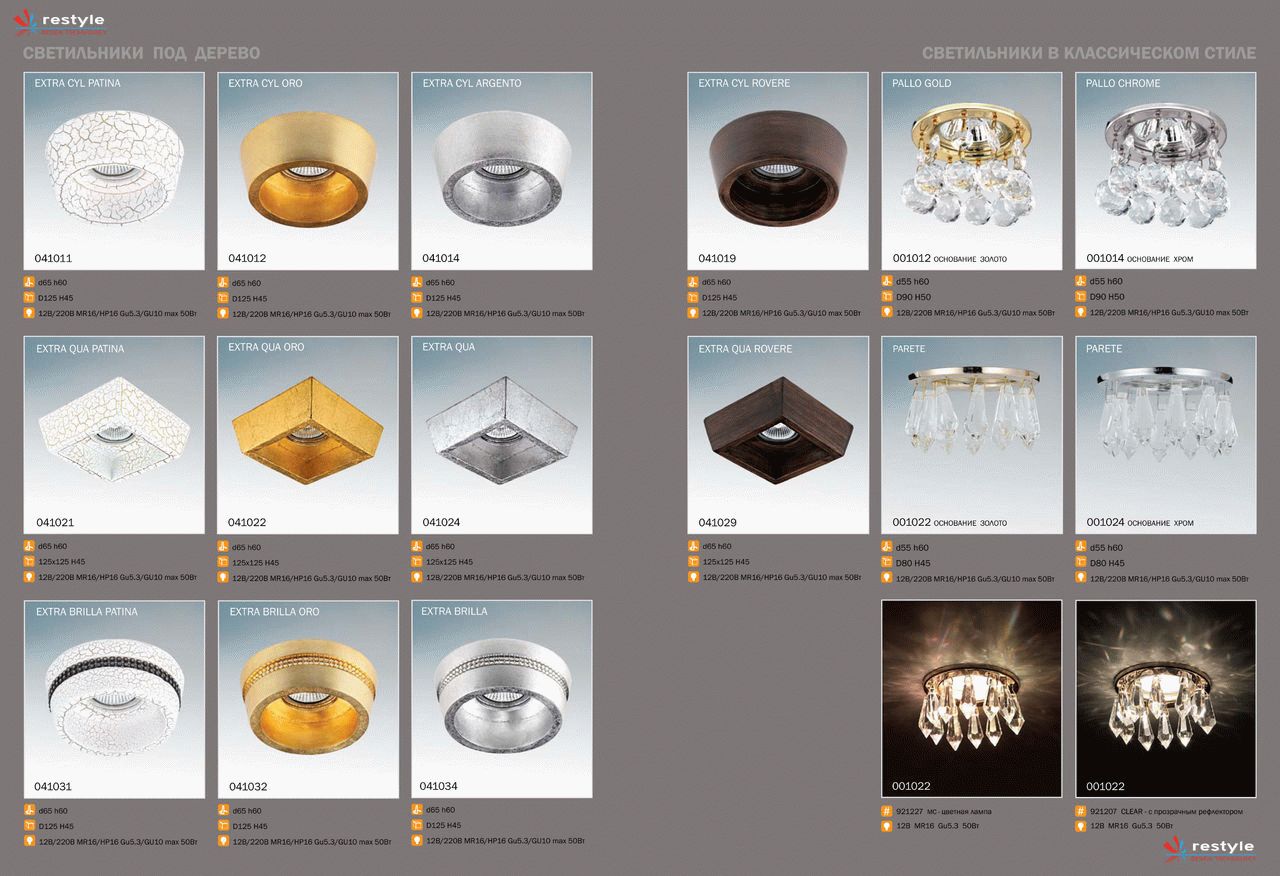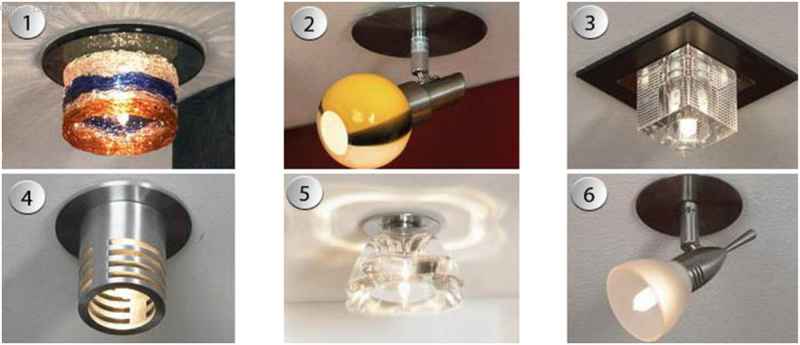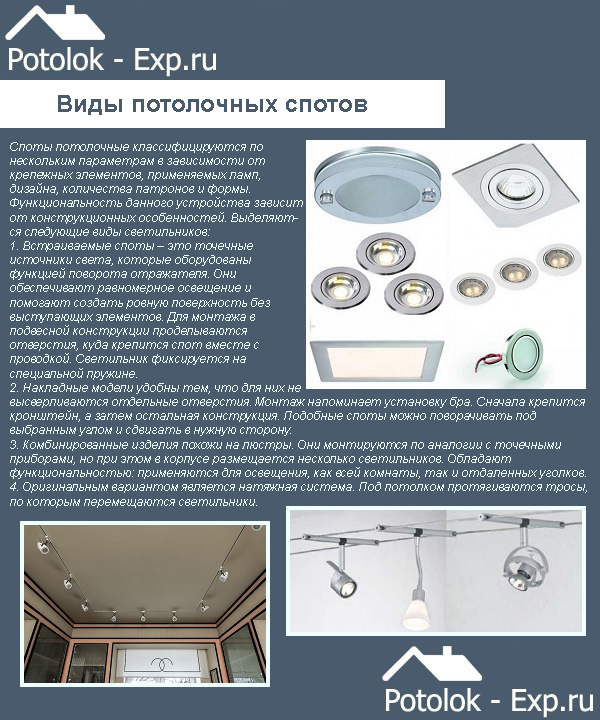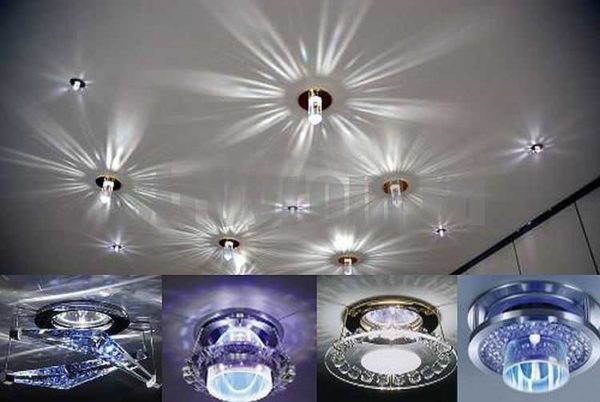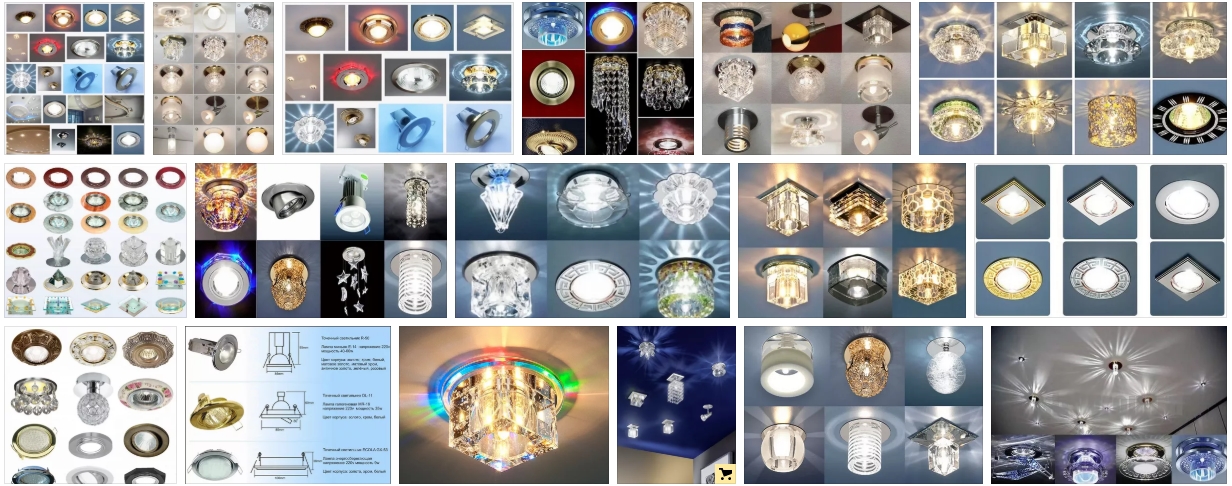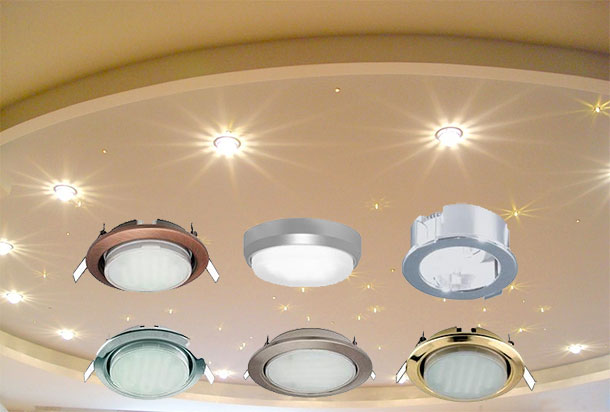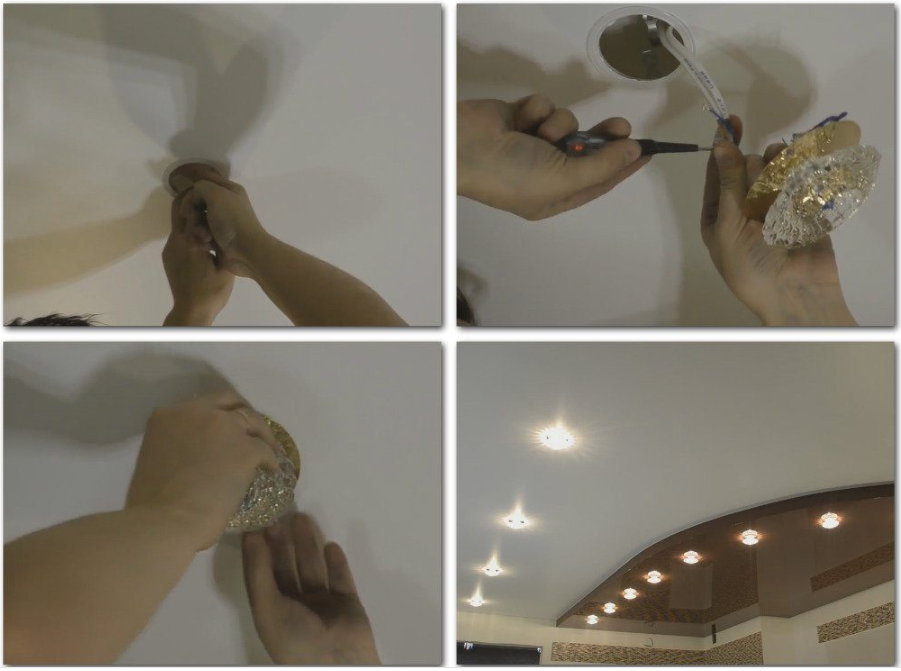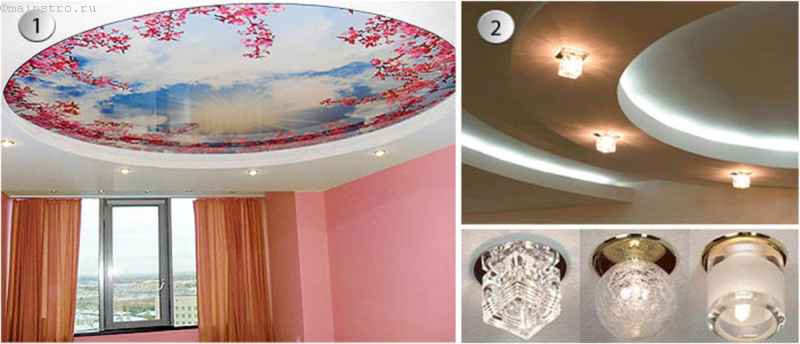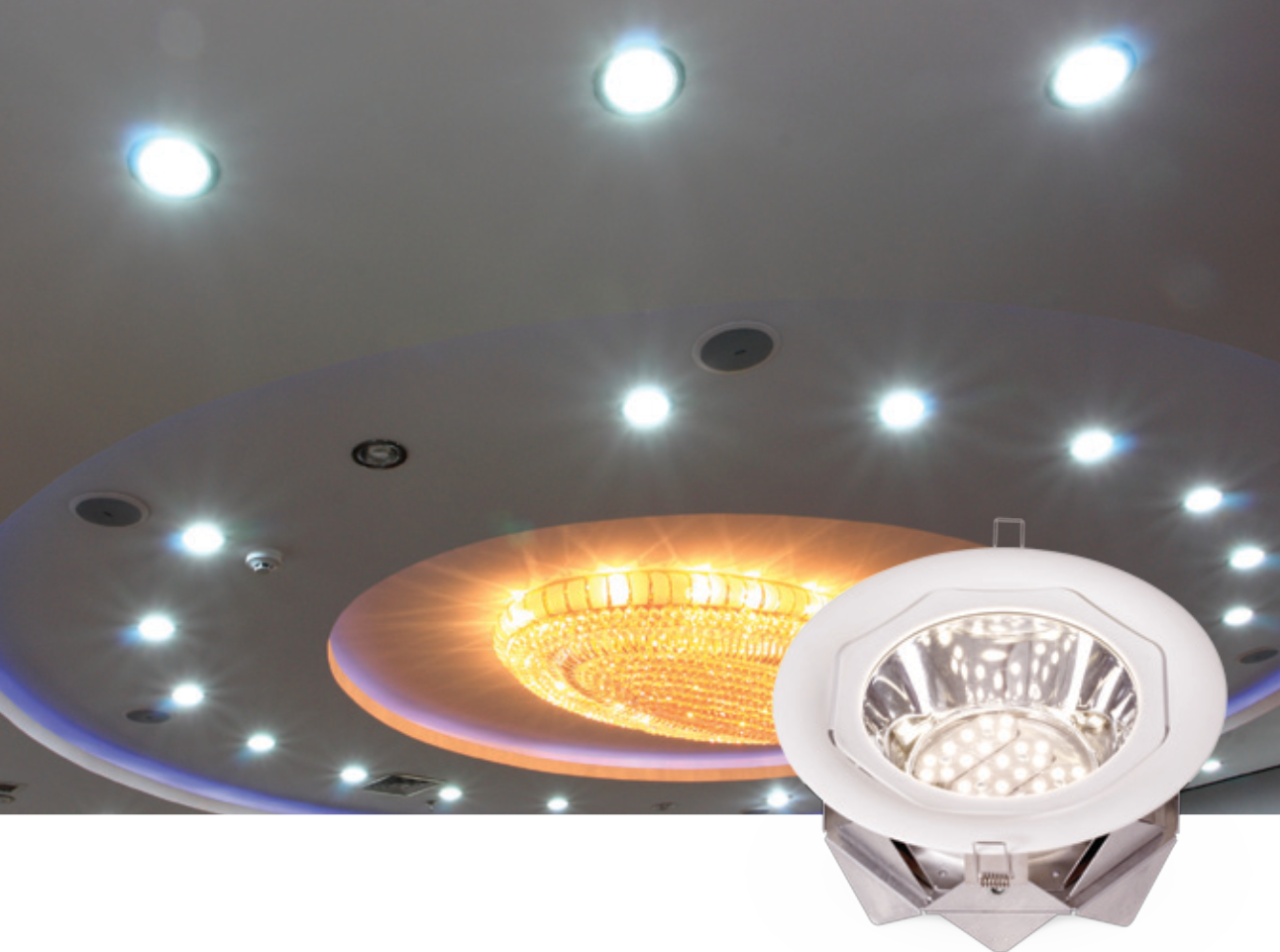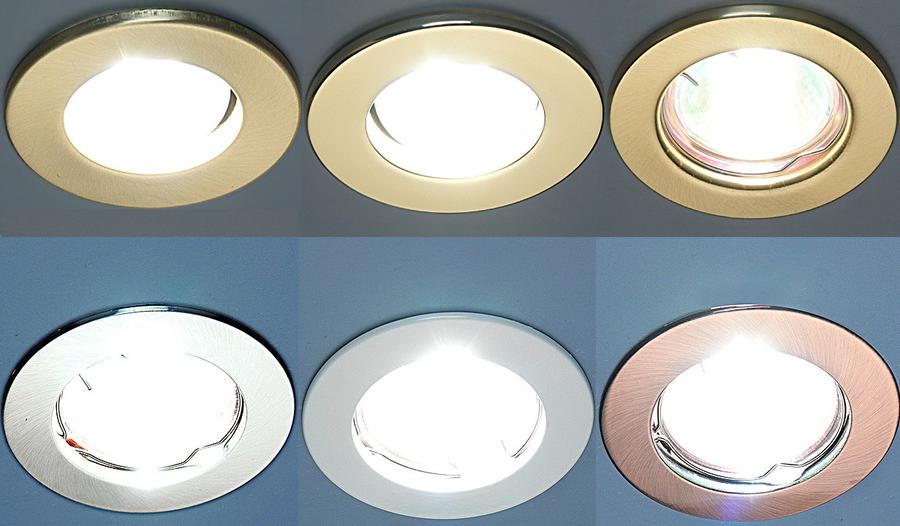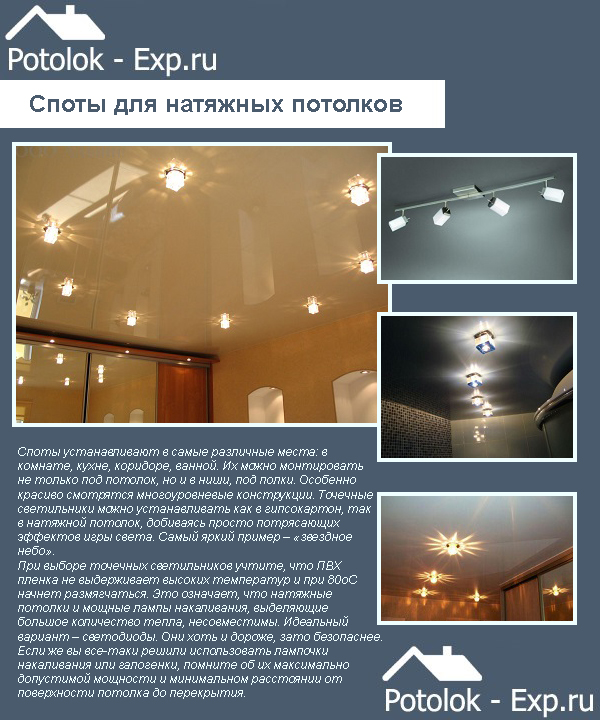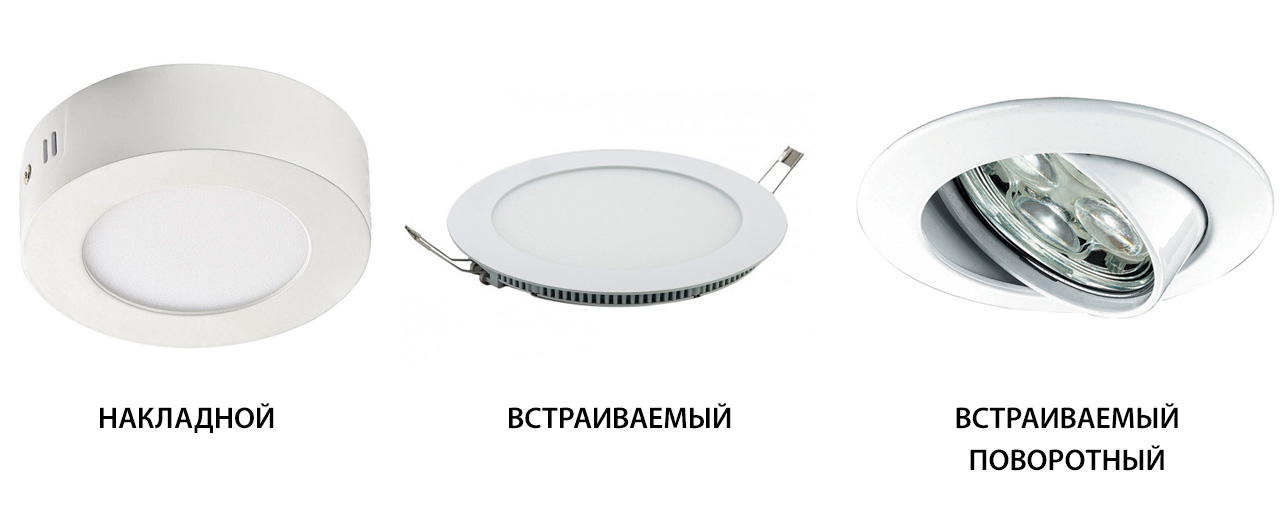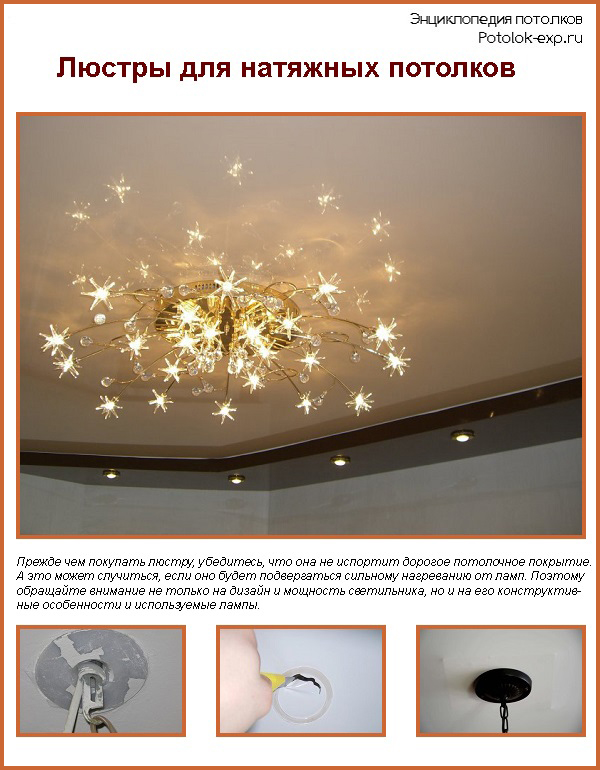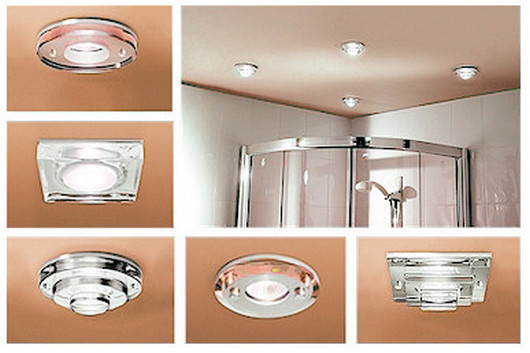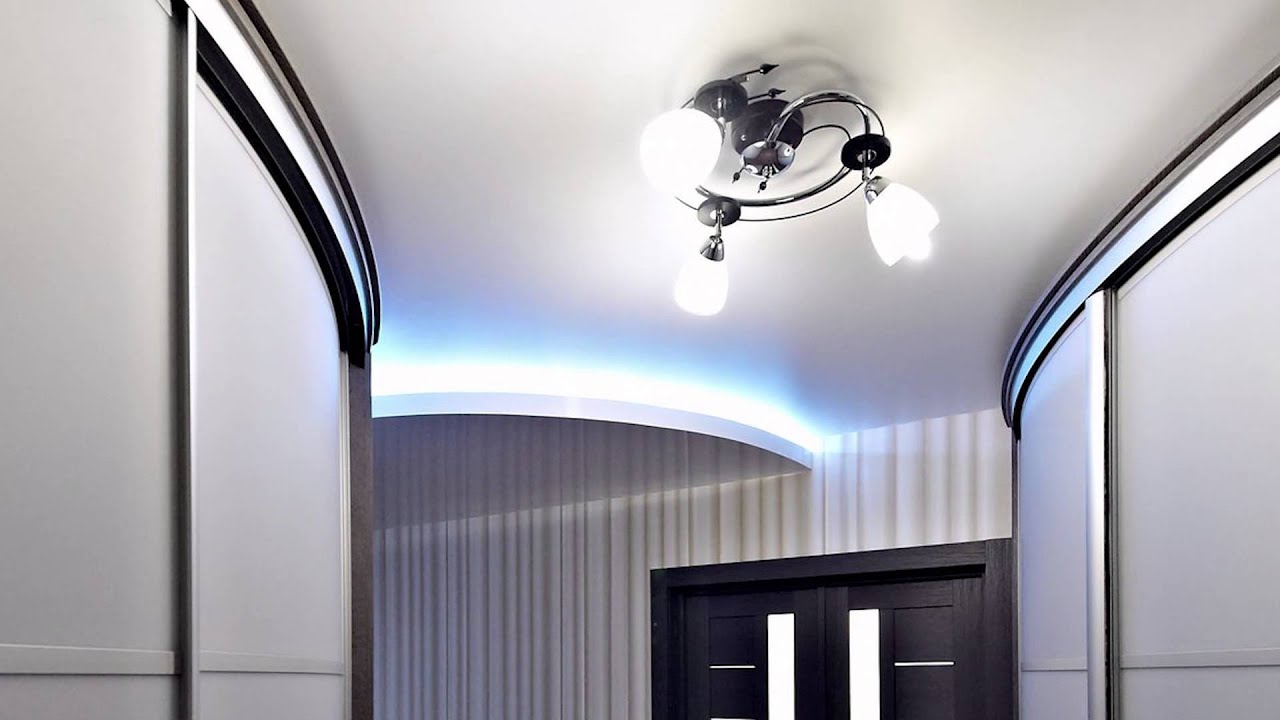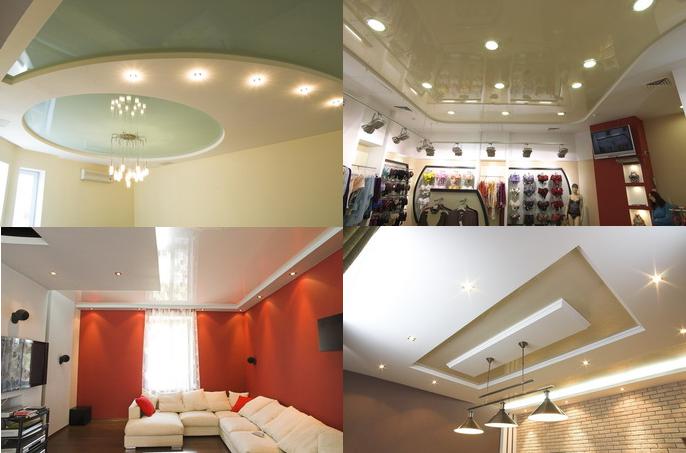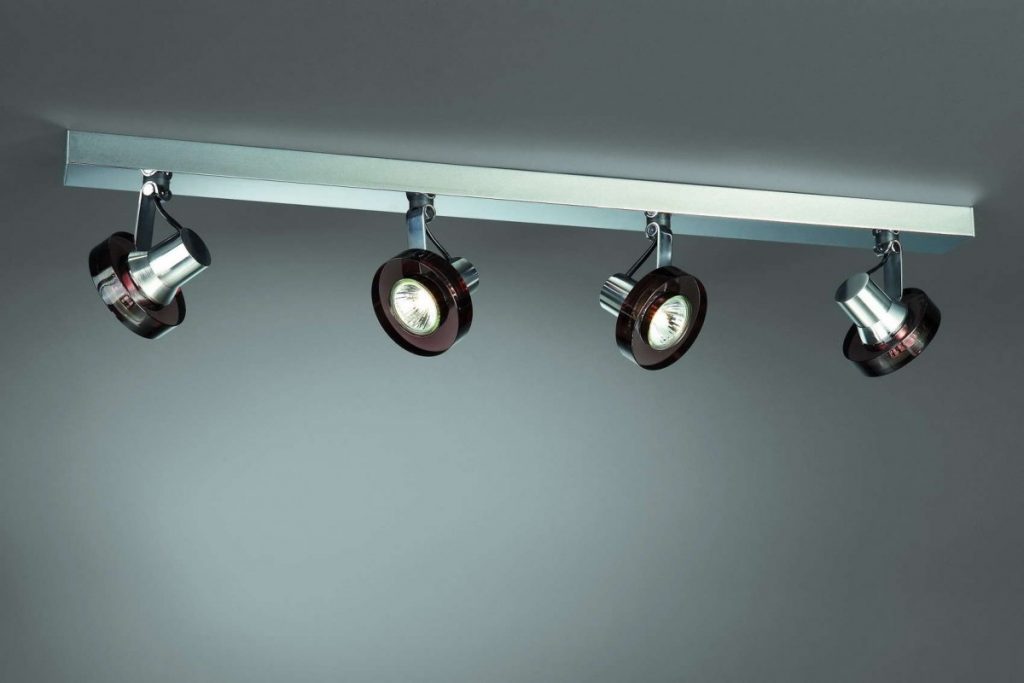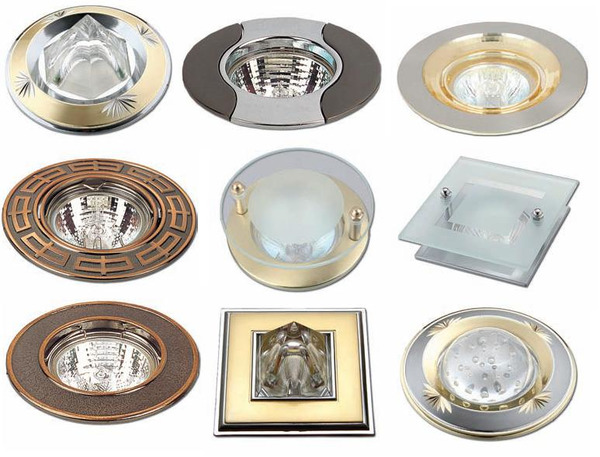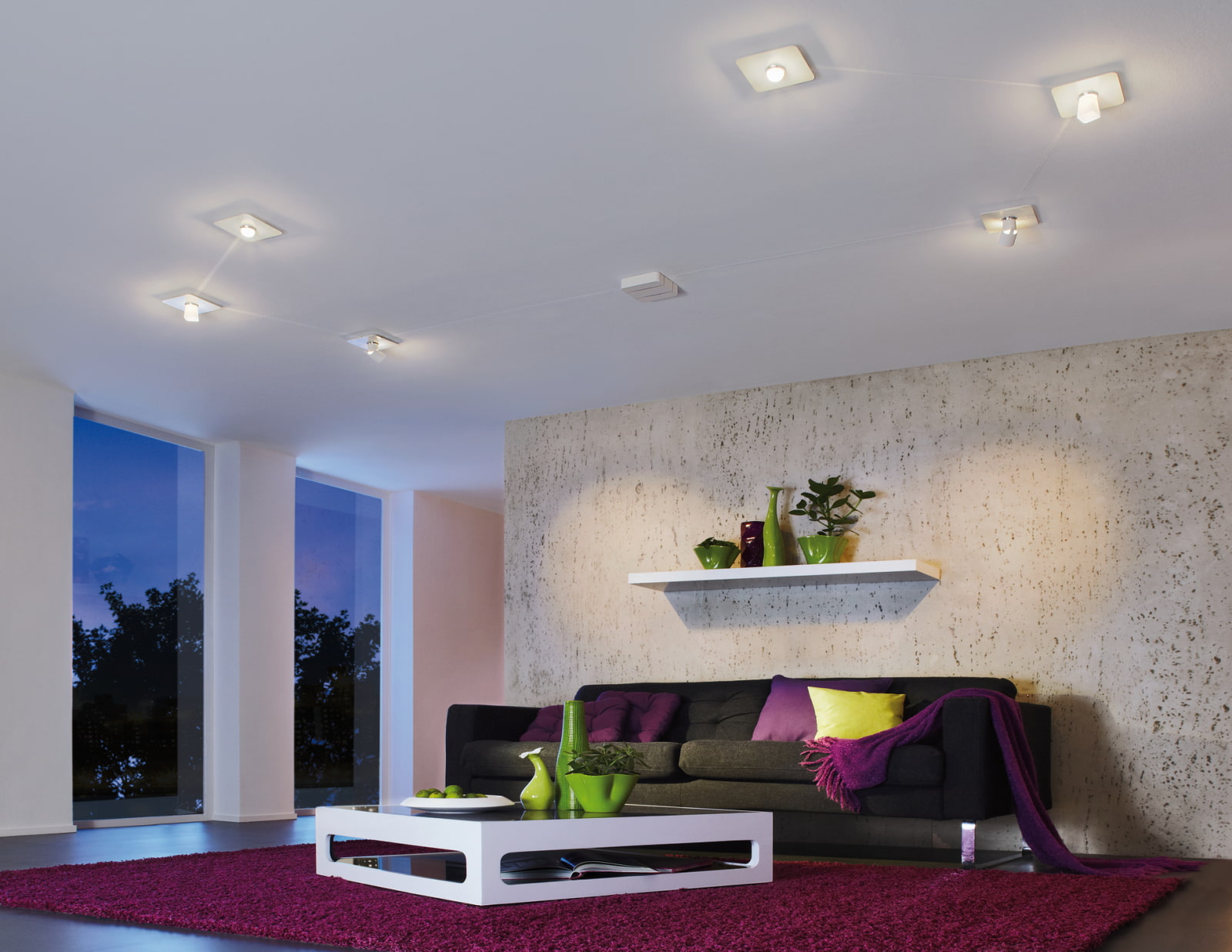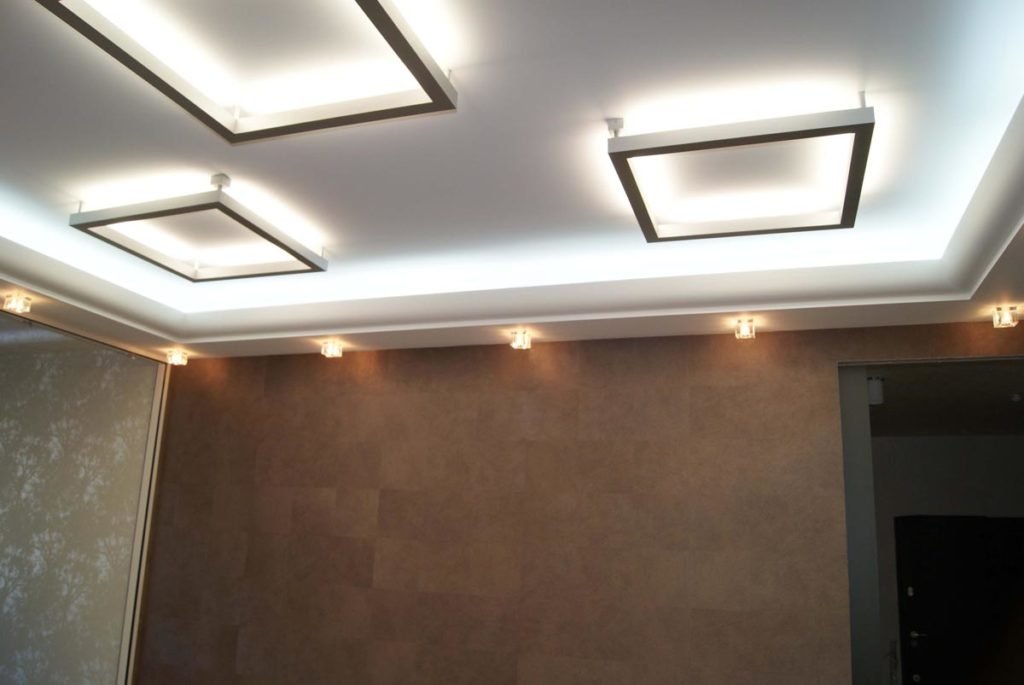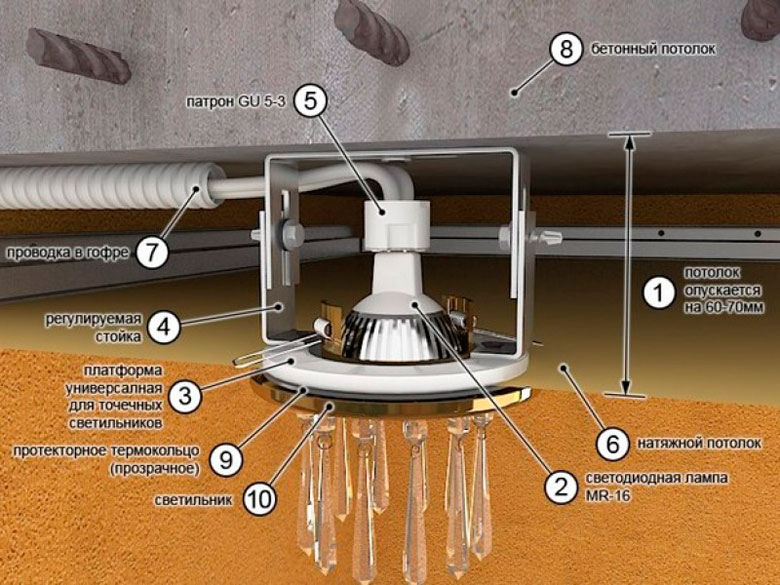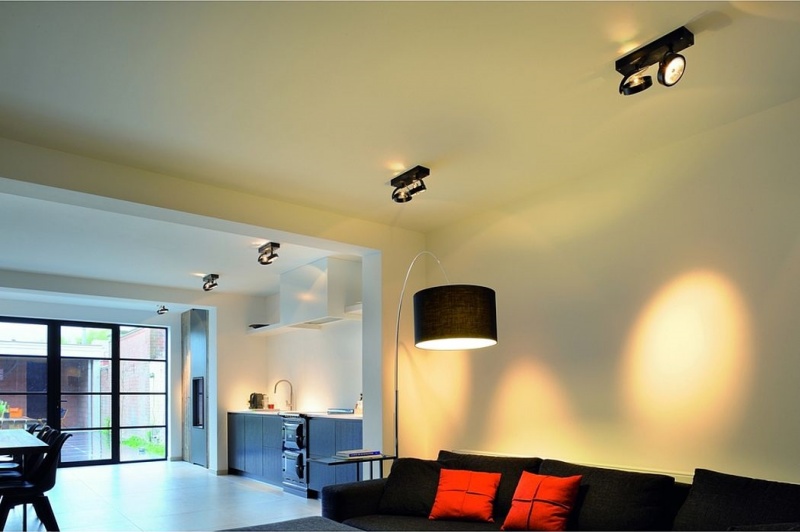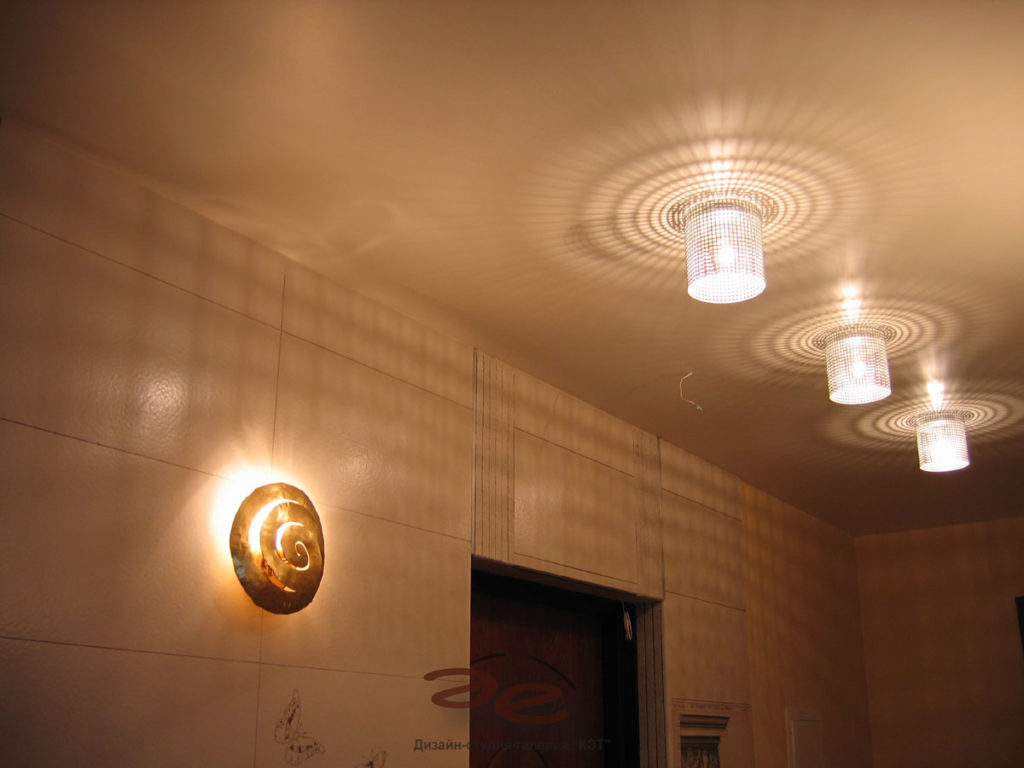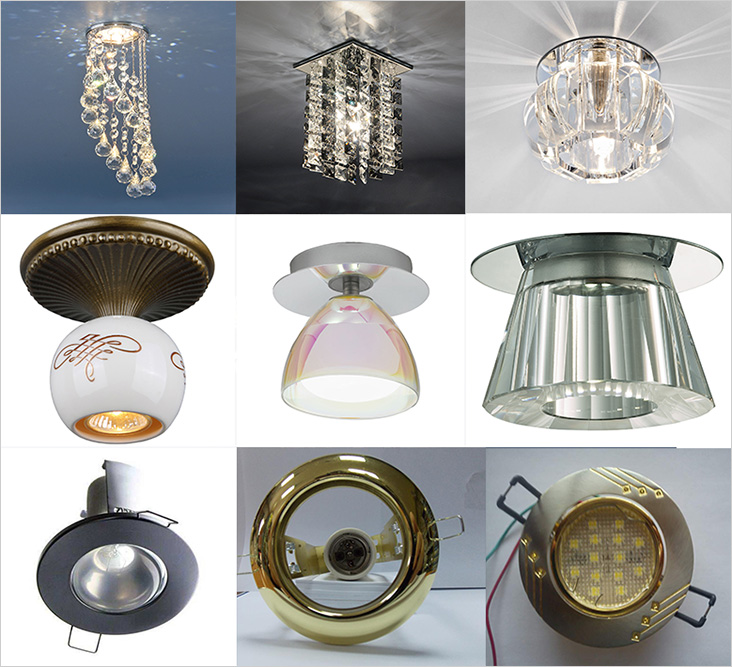Recommendations for the selection of lamps and installation of lighting in a stretch ceiling
- it is best to use types of lamps that do not emit much heat: fluorescent, halogen, LED;
- lamps and elements that heat up during operation must be installed at a safe distance from the ceiling;
- the design of the layout and the wiring of the lighting power network must be carried out before the installation of the ceiling;
- it is advisable to use thermal protection rings;
- the total power of the lighting system in the room is calculated based on the norms of the specific illumination of the luminous flux;
- spotlights on a stretch ceiling, as a rule, are installed at the rate of 1 piece per 1 m2;
- for ceilings with a glossy surface, it is advisable to select lamps, the luminous flux of which is directed upwards. The gloss will reflect the light, evenly distributing it throughout the room and increasing the lighting efficiency;
- accordingly, in matte ceilings, the lamps should be directed downward, because the surface will absorb light, reducing the illumination;
- to avoid the risk of damage to the stretch ceiling, it is better not to buy plate chandeliers with a metal base;
- if for some reason it is necessary to install a chandelier with lamps pointing upwards, it is better to find a model with closed shades. They will protect the canvas from heat;
- spotlights are good for rooms with a low ceiling height, when there is little free space between the main ceiling and the stretched canvas;
- PVC ceilings are temperature sensitive, so LED lights are almost always the best choice for them. The fabric is more resistant to heat, so it is safe to use with both fluorescent and halogen lamps;
- one of the most versatile lighting options is a combined system with a chandelier or large luminaire in the center and built-in spotlights along the edges. This approach allows, if necessary, either to create an exquisite atmosphere in a classic style with a chandelier, or to turn on additional light and provide maximum lighting intensity;
- Regardless of the type of installation, light source and functionality, when choosing luminaires, it is better to give preference to proven brands with a good reputation. Their products, of course, are not the cheapest on the market, but they really have a long service life and correspond to the technical characteristics indicated by the manufacturer.
Features of installation and connection
Before hanging the structure, you need to familiarize yourself with the features of this process. Installation is carried out in several sequential stages:
- System audit. At this stage, technical documentation is studied and measurements are taken.
- Lighting system design. The type and power of the lighting structure is determined.
- Creation of mounting holes. It is necessary to prepare in advance the holes in which the luminaire will be installed.
- Mounting. Products are installed in pre-prepared mounting holes.
- Connection. After installation, the products are connected to the mains.
How to choose a spot?
For a stretch ceiling, the built-in type of luminaires is preferred. In this case, the body of the structure remains behind the canvas, and the outer part turns out to be outside. This design is more aesthetic.
It is also important to pay attention to lamps for devices as the stretch fabric does not tolerate high temperatures. A suitable and common option is economical LEDs that are not subject to heat. It is possible to use incandescent lamps that have a low power of 40 watts
It is possible to use incandescent lamps that have a low power of 40 watts.
In the photo there are recessed spots for a stretch canvas in the design of the kitchen-living room.
Interior features
Different types of luminaires are suitable for different interiors.
Classic
If the room is made in a classic style, then it is necessary to select lamps with a suitable design for it. Products should have regular shapes with smooth lines and proportions. You cannot buy futuristic products for such premises, as they will not look good. Classic lighting fixtures are installed near the ceiling or on the walls. This will help not only decorate, but also align the proportions of the room.
Provence
The Provence style is often used in the design of living rooms. It is similar to the classic one, but still has distinctive features. People who are going to decorate a room in this style often face problems when choosing suitable lighting fixtures. Experts advise using forged metal products, as they will add a certain element of luxury to the interior.
Modern
Many modern apartments are designed in the Art Nouveau style. For such a home, classic lighting devices are not suitable and therefore you will have to look for models with a more modern design. The most modern design for designs produced by Italian manufacturers
Also pay attention to products made by Japanese or Chinese companies
High tech
High-tech luminaires are considered one of the most unusual. Most often, these structures are made of metal, glass or plastic. The shape can be very diverse and therefore you can easily select products suitable for high-tech design. The only serious drawback of lamps is their high cost.
What are the types of spots?
Products are classified according to the type of attachment. There are the following types of spots.
Ceiling spots
They become an addition to central lighting or completely replace it. The advantage of ceiling products is that it provides the ability to change the direction of the reflector
Thanks to this, you can focus on various interior details, highlight a work area or a place to relax. These luminaires are small in size, so they are suitable for rooms with low ceilings
The photo shows the design of a small kitchen with a ceiling equipped with black spots.
Wall spots
Such models can be excellent decorative lighting for hanging shelves or wall paintings. The location of the spots above a desk or computer table will not take up much space and will completely replace a table lamp. Wall-mounted products are also sometimes used as a night light, the main thing is to choose the right power.
In the photo there are wall spots located above the TV zone in the interior of the living room.
Embedded
This type is mounted in the ceiling plane in the same way as recessed spotlights. They are secured with plug-in springs.
By using different glasses, it will be possible to create the desired level of lighting in the room. Devices with frosted glass give a soft and uniform light output, while designs with transparent glass provide precise and directional.
Recessed light sources do not hide the area and are minimally noticeable on a suspended or stretch ceiling.
In the photo there is a black stretch ceiling with built-in spots.
Overhead spots
Surface-mounted luminaires are tightly adjacent to the plane, which is why they have a limited rotation ability. The appearance and performance of such devices is in no way inferior to other models.
The photo shows the design of a modern kitchen-living room with white overhead spots on the ceiling.
Bracket-mounted spots
It is a very popular type of mount, which allows for free changing of the direction of light.Products can have one or more reflectors. The open mount has a different shape, due to which a holistic structure is created that looks quite impressive.
Bar Mount Spots
This model is equipped with several luminaires arranged in one straight or curved line. Certain products have a flexible bar that can accept any configuration. With the help of such a fastening, the devices are used as original illumination for niches or walls. The structure can also act as a central lighting for a small room.
In the photo there are ceiling spots on a square bar in the interior.
Luminaires G9
The third type of luminaire has a G9 base. Their main difference from the previous ones is that here the entire body protrudes from the plane of the ceiling. The bulb itself, respectively, too. In this case, the light is obtained as scattered as possible.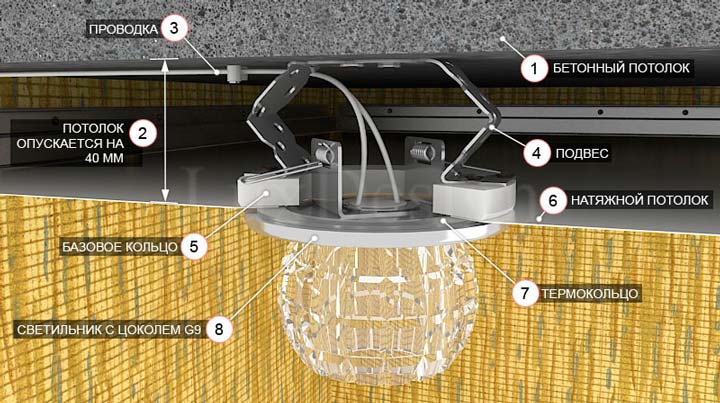
In terms of glow efficiency, they burn better than the G5.3, but slightly worse than the GX53. Among themselves, the lamps can differ in the form of construction, design.
If the structure is glass, then the light passing through the edges will form beautiful patterns on the ceiling. They are mostly seen on glossy ceilings, but the effect will also be noticeable on matte ceilings.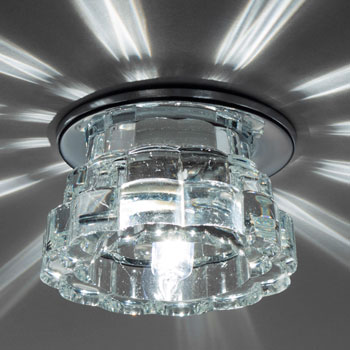
These are all the main types of lamps used in our apartments today. After deciding on the choice of type, the main question for you will remain their effective location on the ceiling.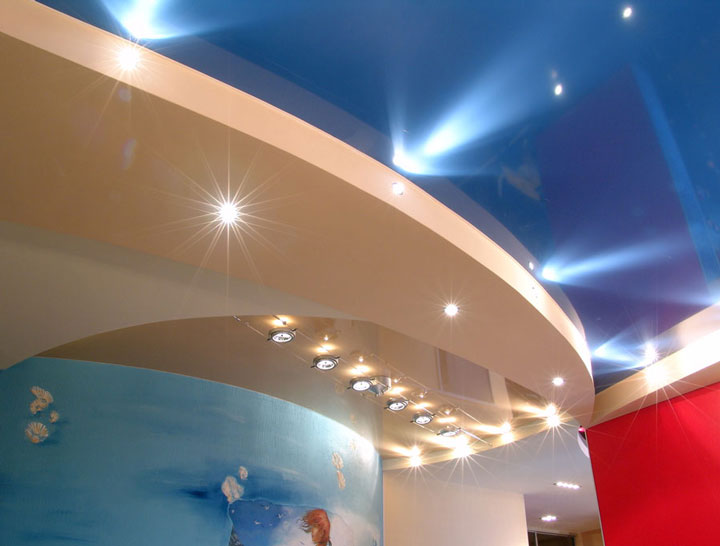
The basic rule here is that if you need to illuminate a large area, it is better to focus not on the power of the lamps, but on their number. The optimal power of the above instances is the following data:
- G5.3 - 5W
- GX53 - 6W
- G9 - 5W
Installation of the luminaire into the ceiling without a mortgage
Another plus of the GX53 H4 - with a certain refinement, they can be mounted even without a mortgage. This may be needed if you do not want to or there is no way to lower the ceiling low.
The whole rework takes a few minutes:
- a standard lamp is taken and the spring-loaded ears are removed, which are designed for a mortgage
- a plate of a certain length is cut from the suspension and inserted from the reverse side
- after which the metal ears are bent with pliers, thereby fixing the plate
As a result, we get such a structure with a height of no more than 25 mm:
After that, the luminaire is inserted into the ceiling and mounted through the holes in the plate using screws.
The only negative is if the bulb has a deep reach (for example, with a round radiator grille in the middle), then this option will not work and the lamp simply will not fit into its place.
Choosing spotlights
The gap between the stretched canvas and the floor slab makes it possible to install built-in light sources. By their design, they can be cut-in, semi-cut or overhead. For lamps that get very hot during operation, a power limitation is provided: halogen - 35 W, incandescent lamps - 60 W if the ceiling is fabric and 45 W if PVC is used. But all the same - it is better not to take risks and do not use halogen lamps on the PVC ceiling.
The cut-in lighting product practically does not protrude beyond the plane of the stretched canvas, which makes them especially in demand for rooms with low ceilings. It should be borne in mind that the heat from the lamp of the "recessed" lamp mainly heats the space above the stretched canvas, therefore, preference should be given to models with a housing made of heat-resistant materials, and choose the right bulbs
Mortise lamps do not illuminate the ceiling with direct rays, do not focus attention on it
For semi-cut structures, the body is located in the sub-ceiling space, and part of the lamp protrudes beyond the plane of the canvas.According to the principle of installation, such a lighting product does not differ from a cut-in one, while the lamp gives off the main heat to the air in the room and heats up the body less. A semi-incised luminaire is allowed to be completed with more powerful lamps. Part of the light rays hit the ceiling, forming patterns on it, especially if the luminaire has a decorative light-scattering rim.
Surface mounted models are externally mounted, they are extremely varied in design and are easier to replace burned out bulbs. The luminaire platforms are made of stamped or cast metal; during installation, a thermal insulation gasket should be used so that the heat from the body does not overheat the canvas
A spot-on spot lamp creates original lighting effects on the ceiling, focusing attention on it, it is best to install bright lamps in them
Semi-recessed and surface mounted luminaires can be fixed or rotary. In the second version, the lamp is placed in a movable module, its light can be directed to a specific area or to a selected object.
Open halogen and LED lamps form a directional luminous flux, which can be diffused by matte plates (for mortise models), rims or shades. Fluorescent and opaque incandescent lamps, even when open, provide soft, diffused light.
When choosing a lighting product, consider the type of its holder: it can be designed for a threaded base (E) or a pin (G). Models with a threaded base have more massive housings - for mounting a recessed luminaire, you may need 7 - 12 cm of space above the canvas. Luminaires with a pin base will take up less space - their mounting height is 5-7 cm. The most compact version is LED “tablets”, flush-mounted models with a height of 3.5 cm.
If you plan to install spotlights in a damp room, you should opt for special waterproof products with a sealed housing.
Video on the topic "which lamps to choose for a stretch ceiling":
Features of creating lighting on tension systems
First of all, it must be borne in mind that it is impossible to fix the lamps directly to the surface of the canvas, since it is made from a thin PVC film or special fabric.
Most often, the first option is used, although such a material does not differ in sufficient strength and heat resistance. Lighting fixtures with traditional incandescent lamps cannot be used, as a section of the film next to such lamps will melt.
When arranging lighting in a room with a stretch ceiling, it is necessary to adhere to a number of requirements:
- The light should be evenly distributed over the area of the room.
- It is advisable to choose lamps that are economical and not very hot. The leading positions in quality are occupied by LED bulbs, since they are quite bright and durable.
- The power, intensity and spectrum of luminescence for all lighting devices or for their individual group should be the same.
- When organizing a hidden type of lighting, the luminaire bodies are placed in the cornices, and rings are attached around the lamps to prevent a rupture of the canvas.
- It is necessary that plafonds and other elements of lighting fixtures go well with the interior, furnishings, and wall decoration.
- To create a soft illumination, the light in the stretch ceiling is directed upward, and to obtain a bright glow - downward.
- The wiring must be hidden. With a hidden installation method, the route is placed inside the walls. This option implies the creation of cable channels for wires.
Methods for zoning space with light
Functional areas with different purposes coexist in the living room. The chandelier unites the room, and local lighting is responsible for the delimitation. There are no strict rules for location, but it is useful to heed the basic recommendations.
The chandelier is in the center, and the places for the rest of the fixtures are determined relative to it. The scheme can be symmetrical when the space is equally highlighted on different sides. In large halls, spots are placed around the perimeter (rectangle or square) or in the form of an oval (circle). With this option, there will be no shadows on the walls.
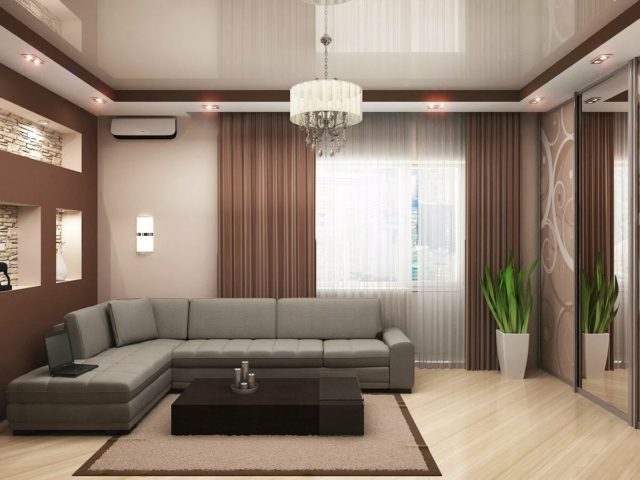
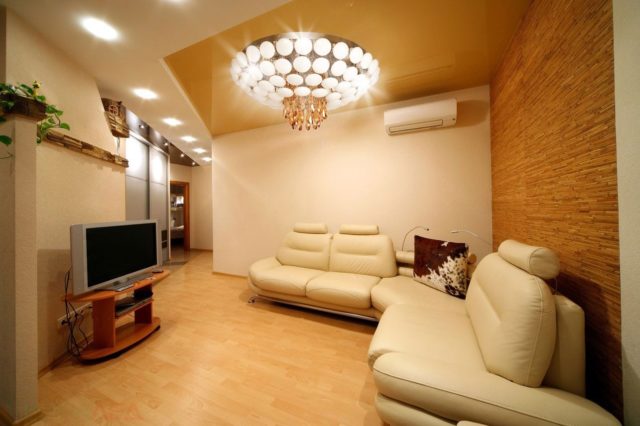

In a room of modest size, there is enough illumination in the corners (this option is chosen for Khrushchev) or along parallel walls. Placing the appliances on the long sides will expand the room. To enhance the effect, light is directed at the walls. And if the rays fall on the ceiling, it will appear higher.
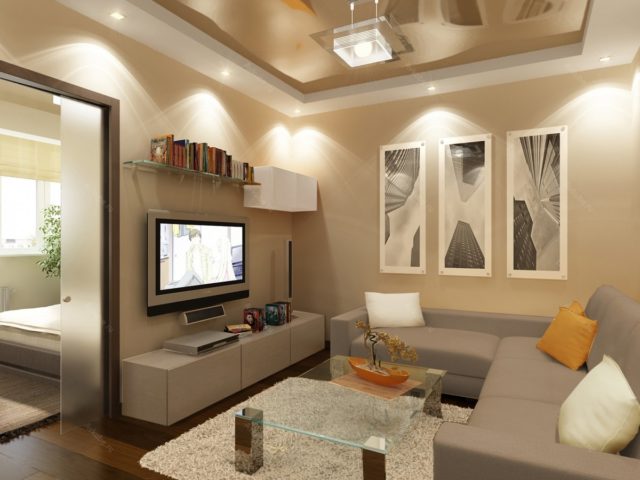
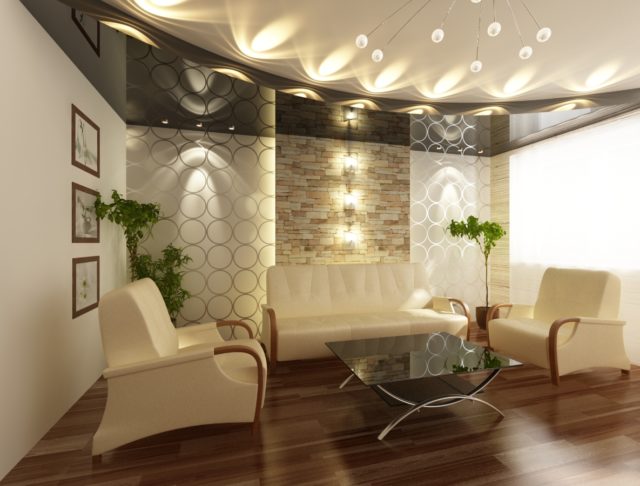
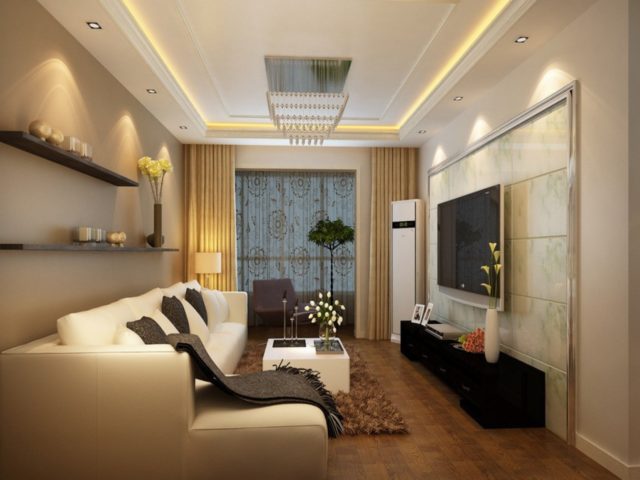
An asymmetrical arrangement of spotlights is chosen when only one zone requires more brightness. This could be a desk or reading chair. If the kitchen is small, a place for a dining group is found in the living room. Then the dining area is also allocated.
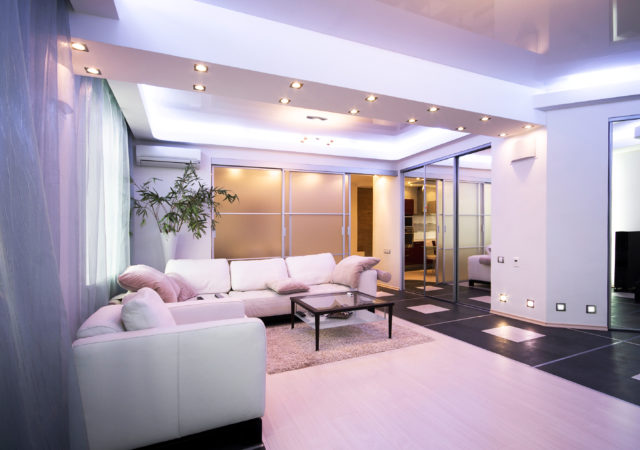

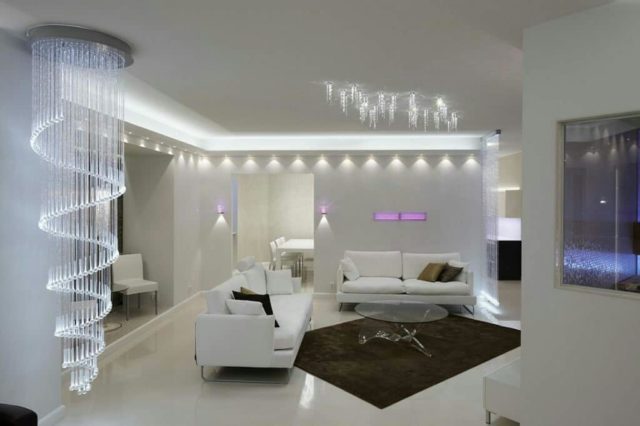

Lamps are arranged:
- in a row near one of the walls;
- corner of the neighboring;
- arc;
- wave;
- or in the form of any other shape.
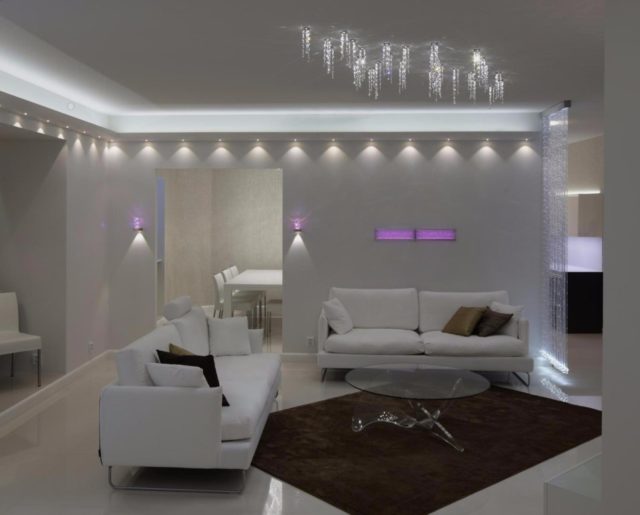
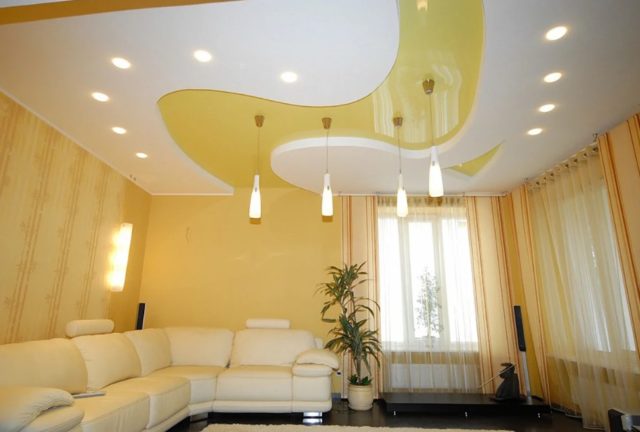
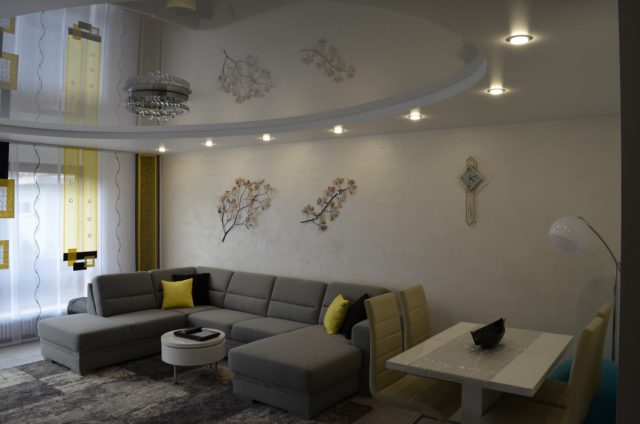
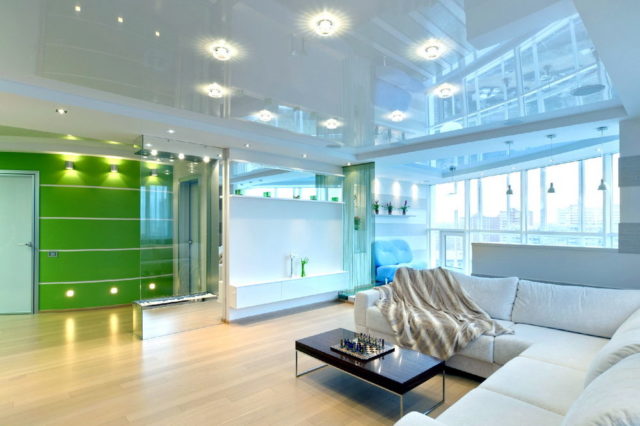
In order for the hall to look harmonious, one more nuance must be taken into account. Light bulbs in all appliances must be of the same color temperature. According to this indicator, light is divided into three groups: warm, neutral and cold. Only the first two are used in apartments.

Information regarding a specific light bulb can be found on the packaging. Color temperature is indicated in Kelvin. It is believed that the difference in individual sources should be within 500 K.
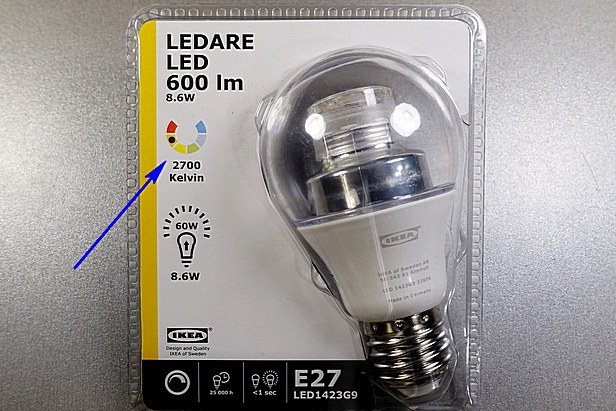
An exception can be made only for decorative light, for example, revealing texture or directing attention to a piece of furniture. Smaller contrast will emphasize a specific point more strongly.


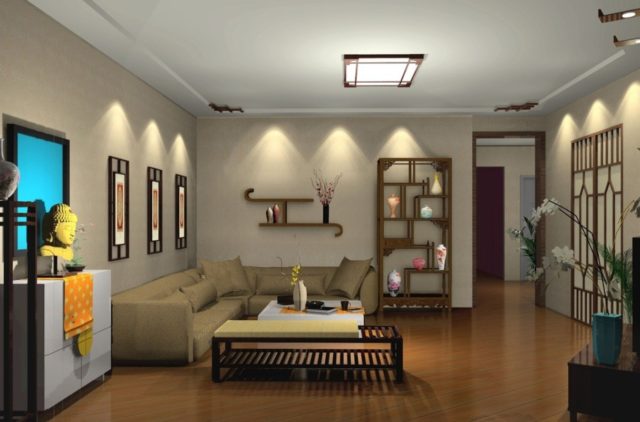
Luminaire selection criteria upon purchase
There are several criteria that are taken into account when choosing a luminaire.
The form
When choosing a lighting fixture, attention is paid to its shape. Products with a rounded shape are popular among buyers.
However, people who want something unusual can choose designs that have other shapes. In stores, you can find rectangular, hexagonal and sinuous lighting fixtures that fit any interior.
The size
It is important to choose the right dimensions of the product, since the quality of the room illumination depends on this. Dimensions directly depend on the manufacturer and type of lighting fixture
However, there are still a number of the most common sizes:
- Stationary. These are popular designs with a diameter of 65 millimeters.
- Turning. Swivel models are slightly more expensive than stationary models. The diameter of the structure is 70-75 millimeters.
Colour
An important parameter that must be taken into account when choosing a luminaire is the color palette of the lighting. For most rooms, products are selected that are capable of providing natural daylight. Its advantage is that it does not distort the shades and colors in the room.
However, for bedrooms or children's rooms, you can pick up lighting fixtures with multi-colored shades.
Degree of protection
Lighting devices are exposed to various dangers on a daily basis. Over time, a lot of dust particles and moisture settle on them. They can also deteriorate from sudden changes in voltage. Therefore, it is recommended to choose models of luminaires with built-in protection. Their surface can be treated with compounds that protect it from moisture. Expensive models have grounding, which will protect against voltage surges.
Unusual lighting options
Now we will consider more rare options, the installation of which is possible only with a stretch ceiling. Some ideas combine with more traditional ideas, others don't. But all give the living room an original and modern look.
Luminous ceiling
This option is suitable as the main lighting, instead of a chandelier.You will need a translucent film, which is stretched over the entire surface. Preliminarily, diodes are fixed on the ceiling - in the form of panels or LED-tape, laid in rows. When turned off, the ceiling looks like a regular flat surface (white or slightly grayish). And when working, it emits a fairly bright, but soft and diffused light.

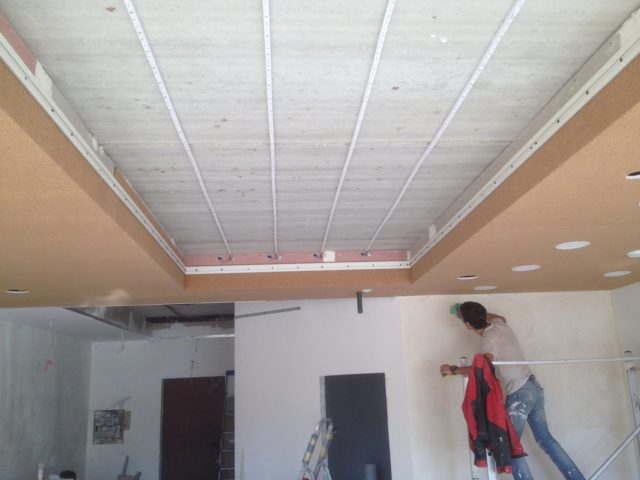

Sometimes, not the whole plane is drawn up in this way, but only a part, it turns out a window in the ceiling. This technique can be combined with a two-level design.
Photo printing looks good. Usually, plots are chosen that visually increase the height - clouds, tree branches, buildings directed upward, etc.
Starry sky
This kind of lighting in the living room creates a relaxing atmosphere. But it is not suitable as the main source, it rather plays a decorative role.
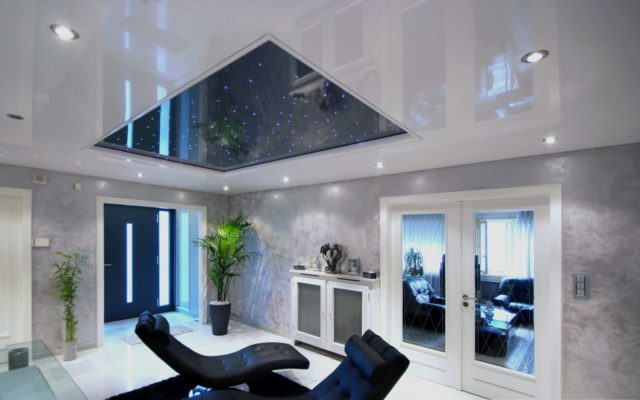
To create you need:
- PVC film;
- a bundle of fiber optic filaments;
- projector;
- sometimes they additionally take Swarovski crystals.
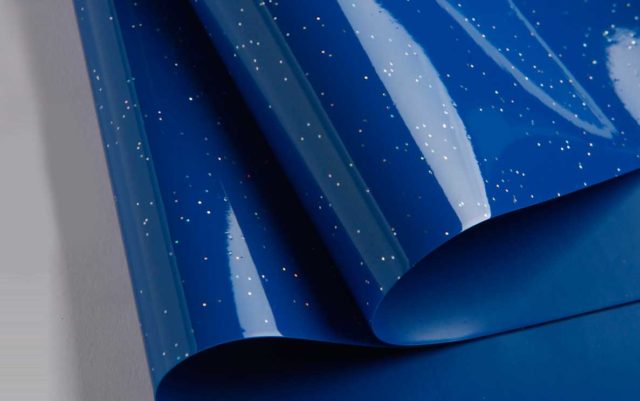
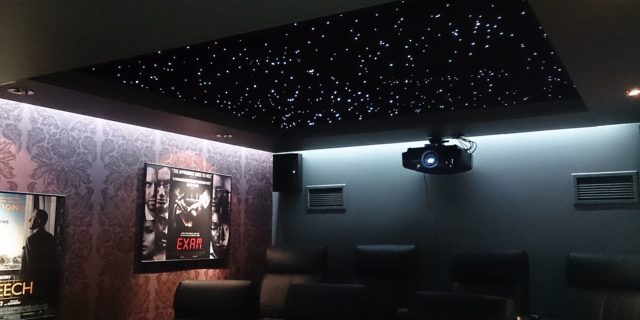
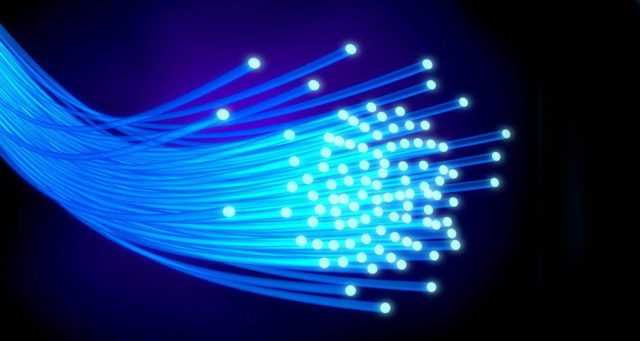
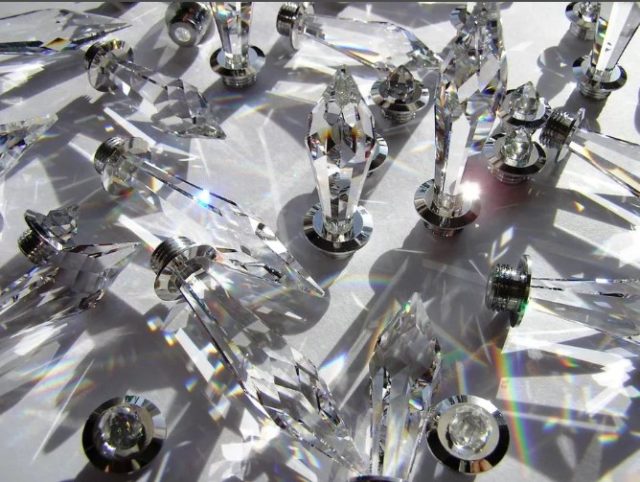
Most often, black canvas is used, other dark colors (blue, purple) are also suitable. Photo printing with the image of stars, galaxies or zodiacal signs is appropriate.
The projector is fixed on the site, mounted near the floor, fiber optic is connected to it. The film is stretched, and then holes are pierced through which the ends of the threads are passed. They are cut in a millimeter from the stretch fabric. Transparent crystals are glued to some points. When turned on, the light will give the impression of burning stars. The Swarovski crystals refracting it resemble large celestial bodies.
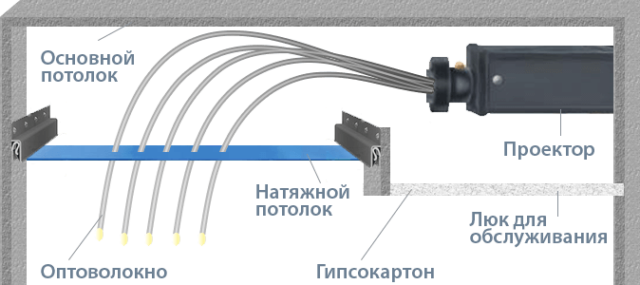
There is another technology, not so spectacular, but simpler and more budgetary. Ceiling lighting is made using diodes. The canvas is pierced with special Starpins pins, which transmit and beautifully refract rays.
Light lines and patterns
This is another use case for LED strips. The strips are placed in baguettes fixed to the ceiling. A film that allows light to pass through is stretched below. After switching on, patterns appear on the surface.
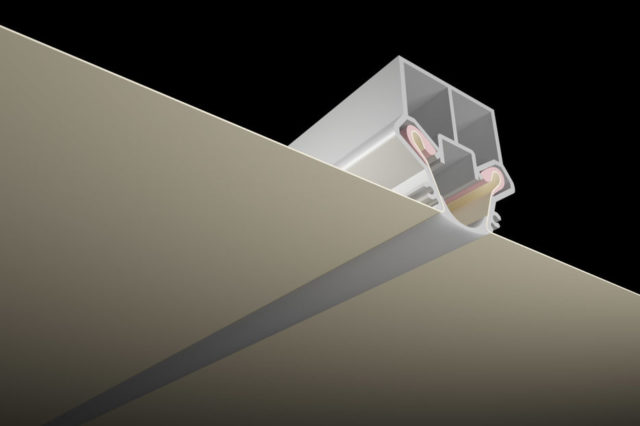
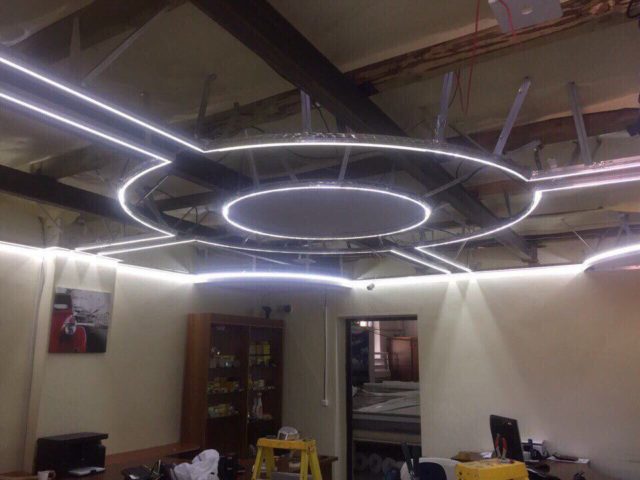

Ceiling lines can be straight or curved, intersecting at any angle. Drawings and even words are made of them. This type of lighting complements the chandelier and spotlights, draws attention to a certain area, but is also used independently as the main lighting. The drawing can be made in color by laying the RGB tape.
Soaring ceiling
In this case, the diode strip is laid along the perimeter of the room. They use special profiles that create a small gap between the ceiling and the wall, and also hide the LED strip from the eyes. As a result, the impression is created that the surface does not lie on the ceiling, but hangs above it in the air.

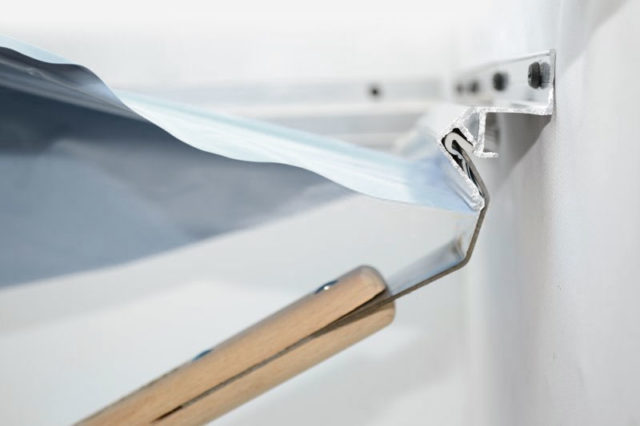

Soaring can be not only a single-level ceiling. If you select a niche in this way, the upper level of the multi-tiered structure will appear higher.
As with the previous version, a chandelier and spots are also installed in separate zones. The perimeter backlight is sufficient to create a cozy twilight, for example, for watching movies.
Varieties of luminaires for stretch ceilings
Tension structures are quite demanding in the choice of lighting devices. There are several types of luminaires that are suitable for installation in such a canvas. Depending on the fixation option, the following varieties are distinguished:
suspended;
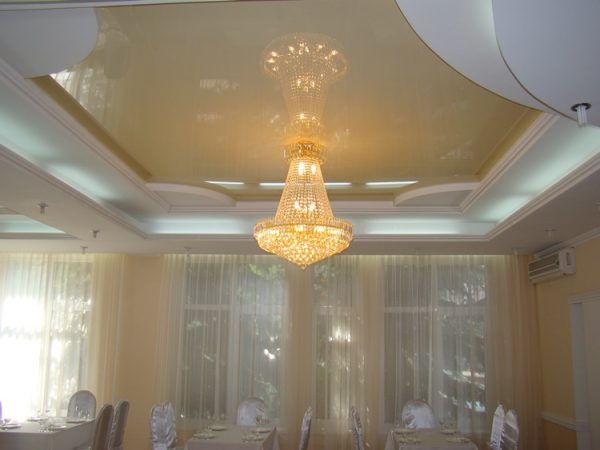
waybills;
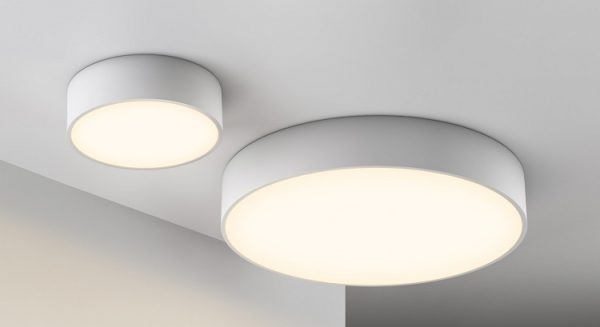
built-in.
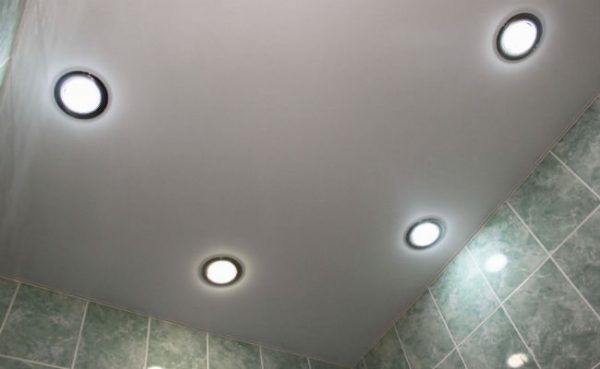
Suspended lighting devices (chandeliers) are fixed on a special hook attached to the main ceiling. Most often, such devices are mounted in the hall, since they include several lamps, which allows the space of the overall room to be provided with light.
Installation of overhead devices requires more extensive preparatory work. Such luminaires need a mortgage base equipped with an electrical power supply. These lamps look good in living rooms, but they can also be installed in a small bedroom.
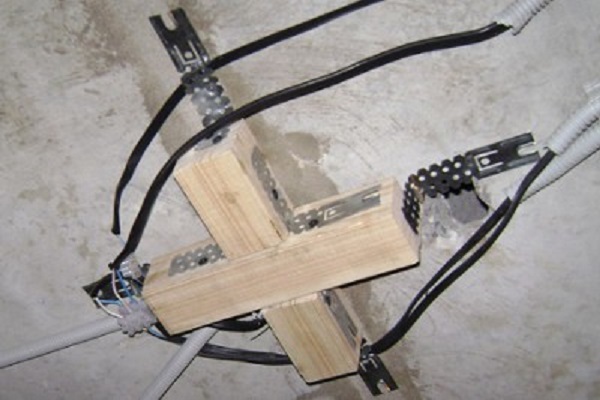 Luminaire connection
Luminaire connection
Installation of recessed luminaires is carried out in the same way as in the case of overhead. Their peculiarity lies in the fact that they are equipped with a spring-type retainer, which is located in the hole of the tensioning structure. On the outside, a decorative overlay is mounted, thanks to which the impression is made that the device merges with the canvas.
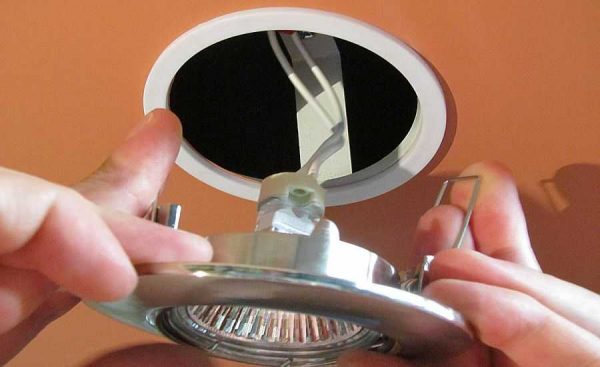
In addition, all luminaires used for tension structures are classified into types according to the number of light sources. Consider what types of devices exist depending on this criterion:
point;
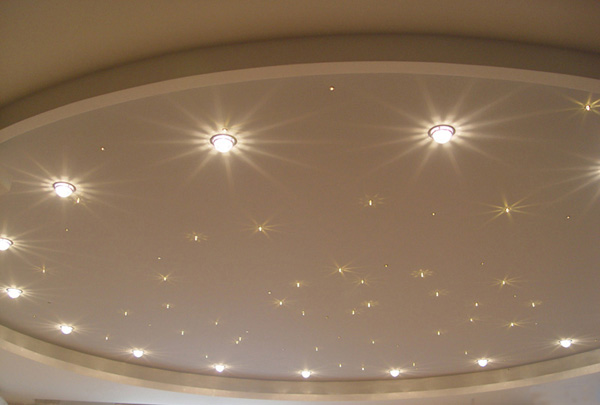
cascading.
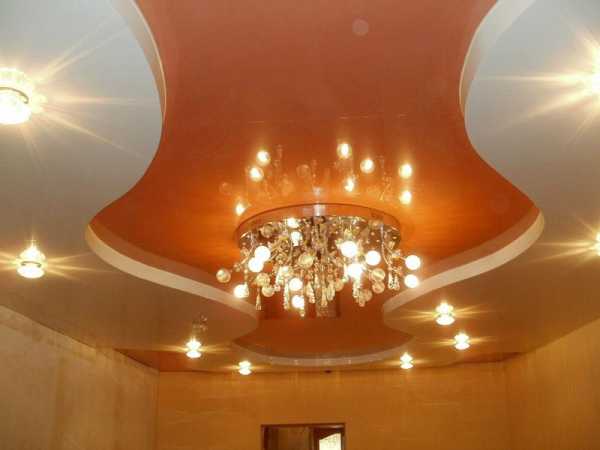
Point-type lighting devices are small in size, so they consist of only one lamp. If you decide to use such devices to illuminate the room, then several lamps will be required, since one will not be enough. The illumination area of point products is usually only 30 degrees. Correct installation of such devices involves installation in a row.
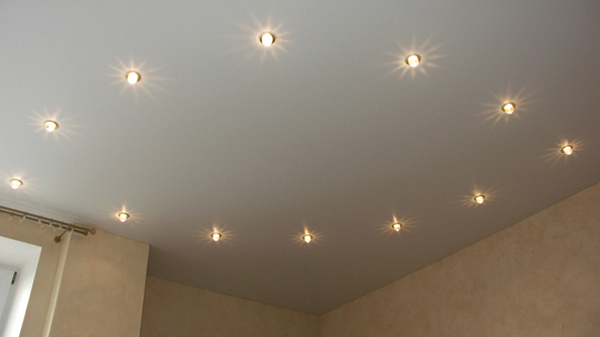
Useful information! Spotlights work best in small spaces. They can be installed in the kitchen or in the hallway.
Cascade lighting is represented by integrated structures that include a base (platform) and lighting fixtures directly. This kind of lighting is ideal for the dining area. The cascading platform with lamps can be positioned directly above the kitchen table.
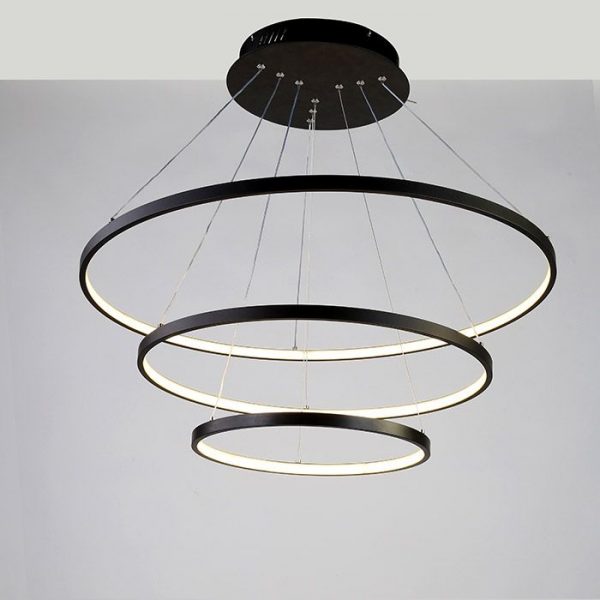
The last criterion by which these devices are classified is the used light source. On sale you can find LED, halogen and fluorescent devices. The first of them are powered by a semiconductor (LED). These devices produce warm light that has a yellow tint. You can also find models that give cool white light.
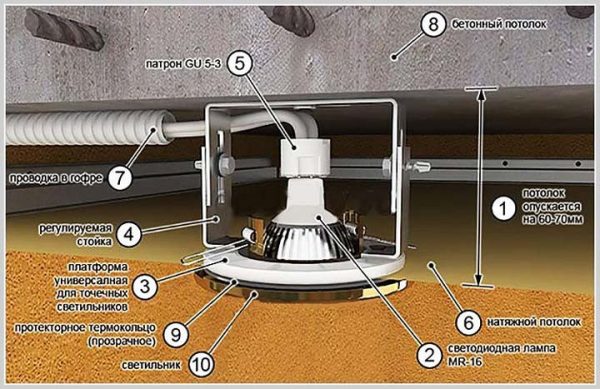
LED devices practically do not heat up, so they are great for stretch ceilings. Among other things, they belong to the group of energy-saving devices. Their main disadvantage is the impossibility of replacing the lamp. It is built into the device, so if it fails, you will have to change the lamp to a new one.

In turn, halogen devices have increased brightness and good color rendering. They are not energy efficient, but they last twice as long as standard bulbs. Such luminaires can be chosen to illuminate a small space, for example, they can be installed in a corridor.
Luminescent models are characterized by high luminous efficiency and are classified as energy saving. The main disadvantage of such devices is their size, which imposes certain operational restrictions on this type.
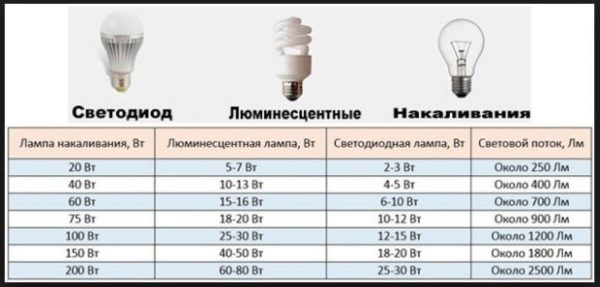
Interesting: Installing a two-button light switch
conclusions
Different types of lighting perform different functions. The preferred option is chosen taking into account the purpose and characteristics of the room.
In the rooms and in the kitchen, the chandelier and spotlights are installed on the stretch ceiling together. Built-in spots can be unevenly distributed, concentrated in the necessary areas: where they cook, read, sew, etc.

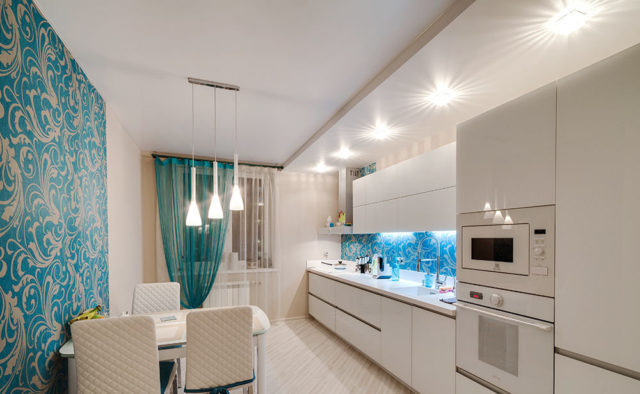
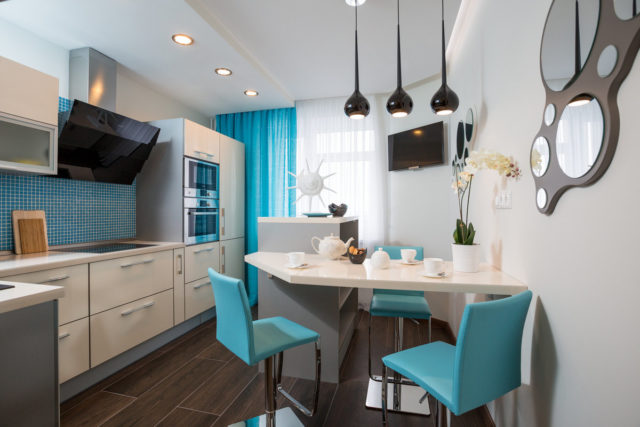
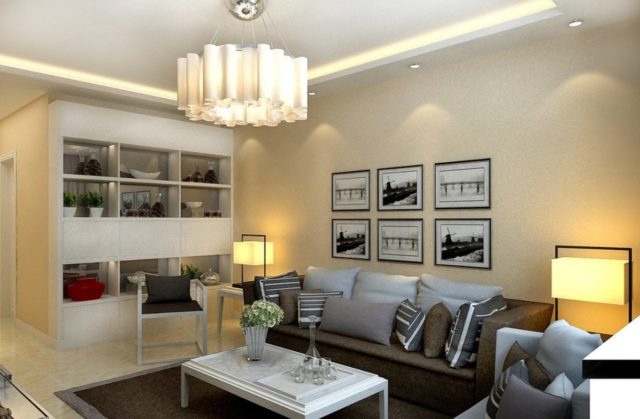
For small spaces, such as bathrooms and corridors, built-in spots are sufficient. A chandelier in such spaces will look too cumbersome, and several lamps are enough for full lighting. In elongated corridors, they are placed in a row. And for bathrooms and compact hallways, corners are often chosen.
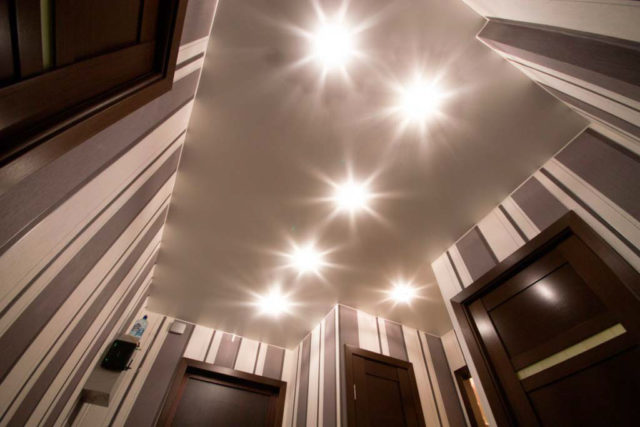
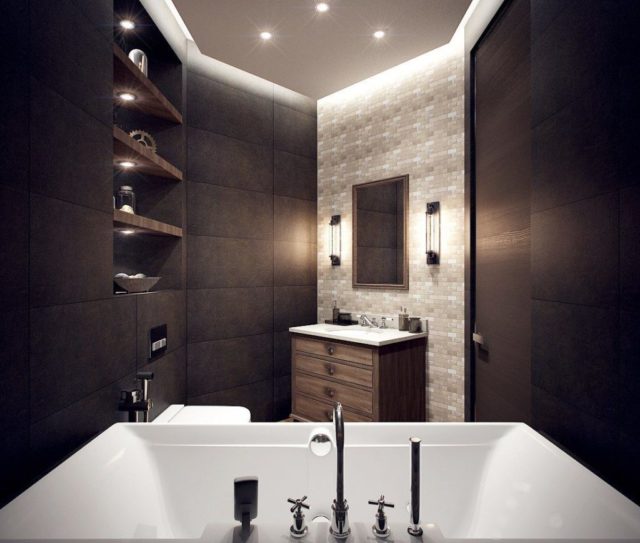


It is necessary to choose a lighting scheme before installing the stretch ceiling. Then it will be possible to prepare in advance - buy suitable devices and make mortgages for them.


